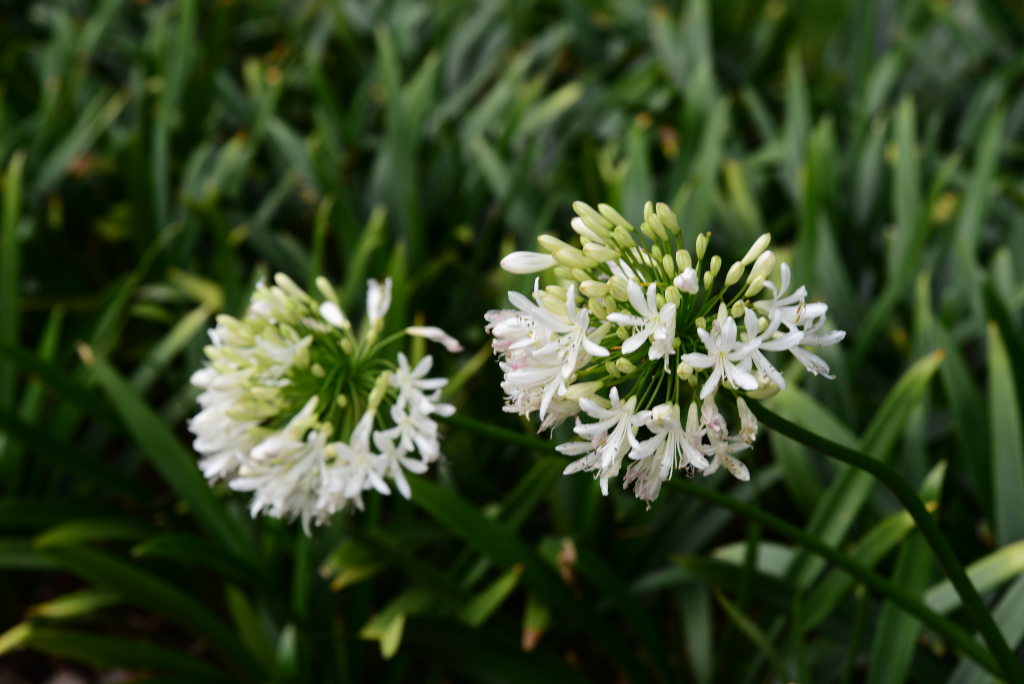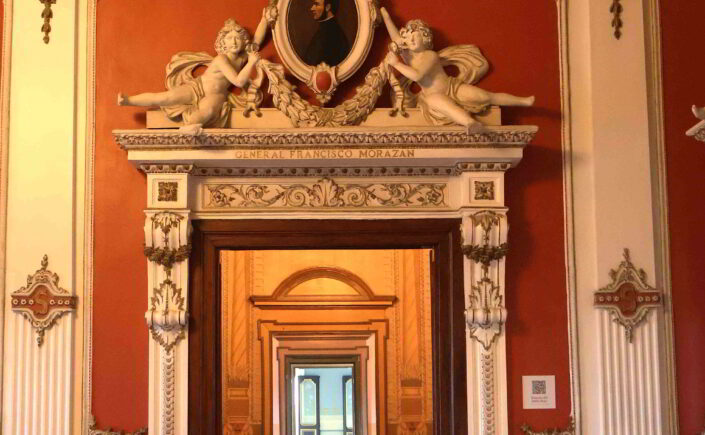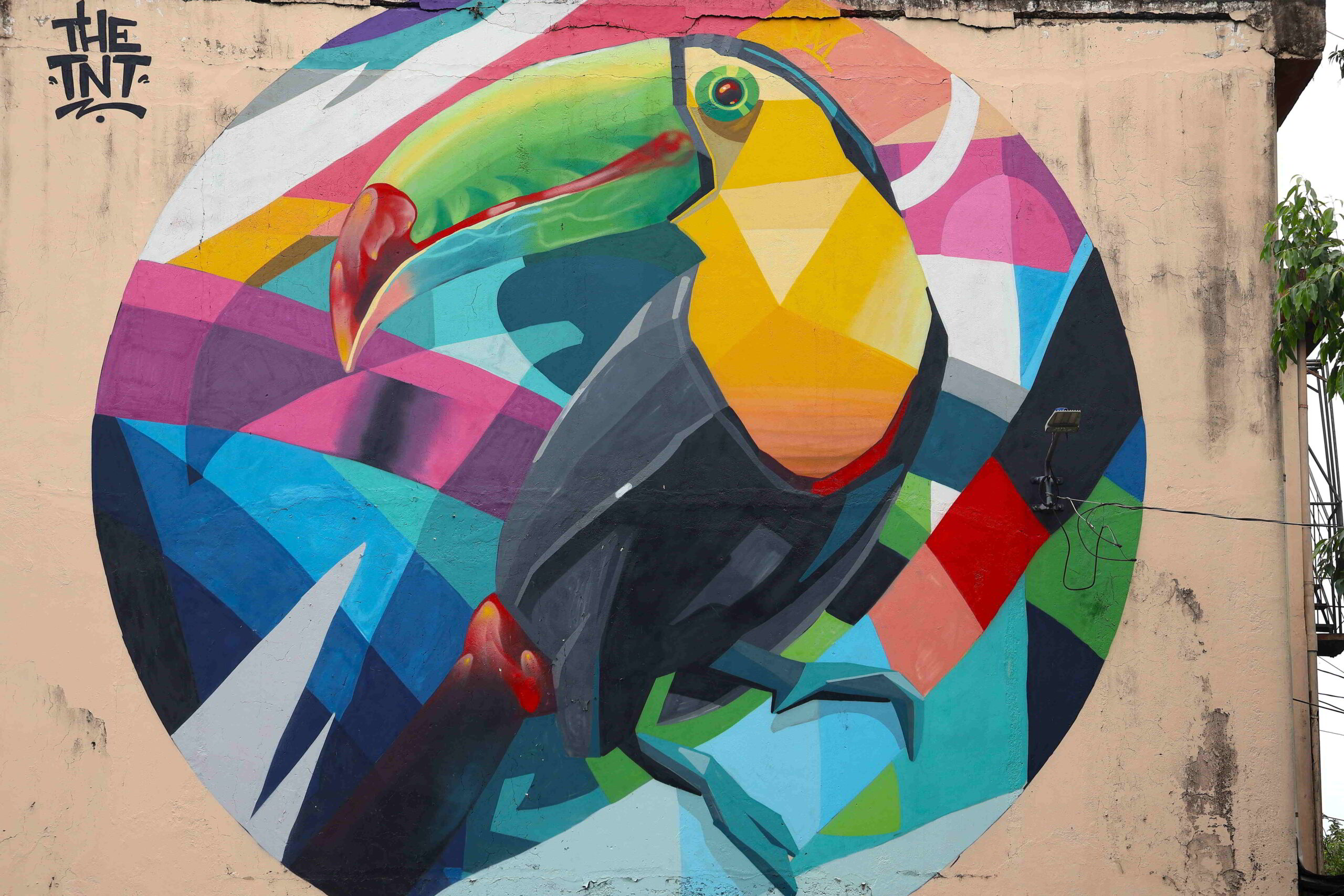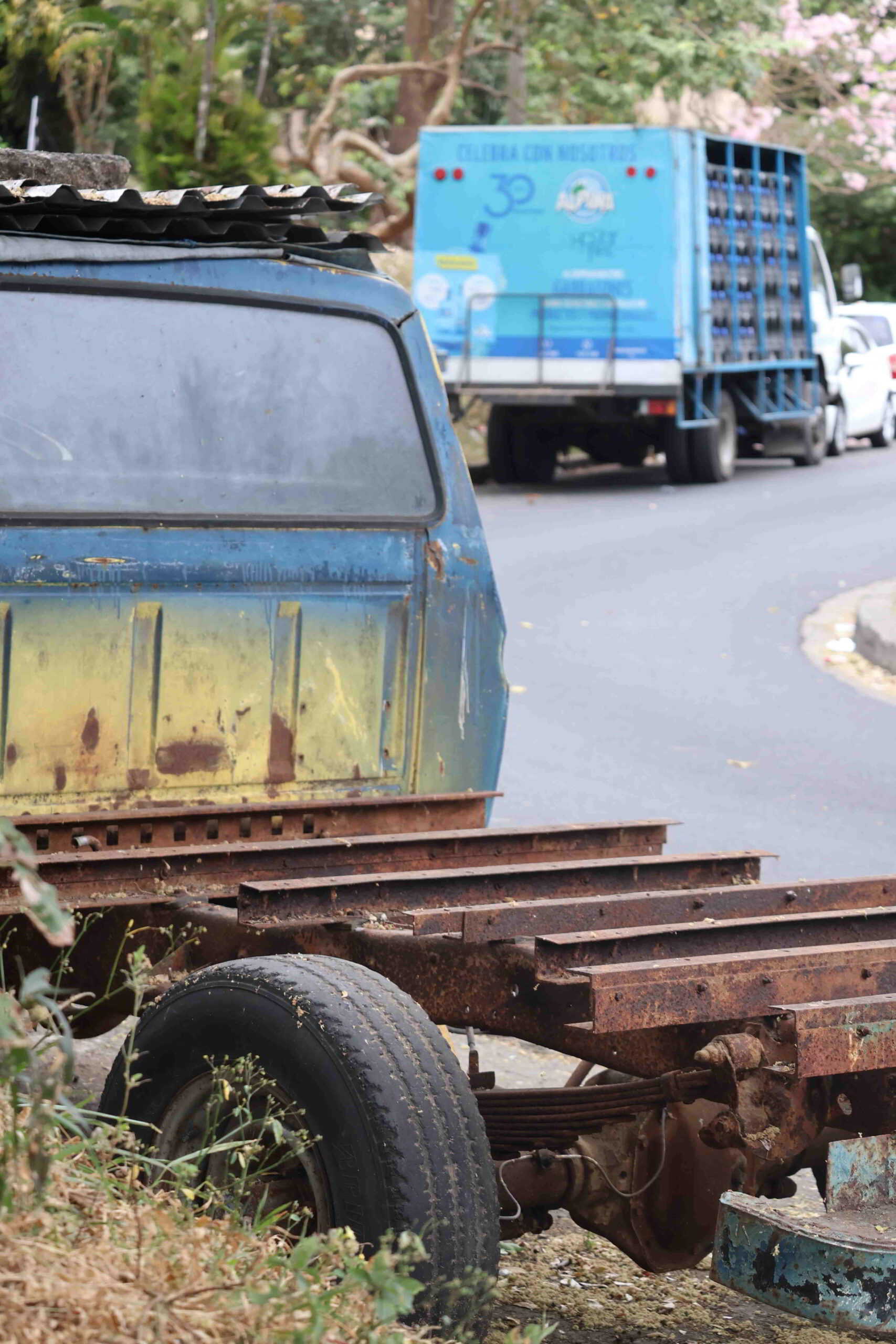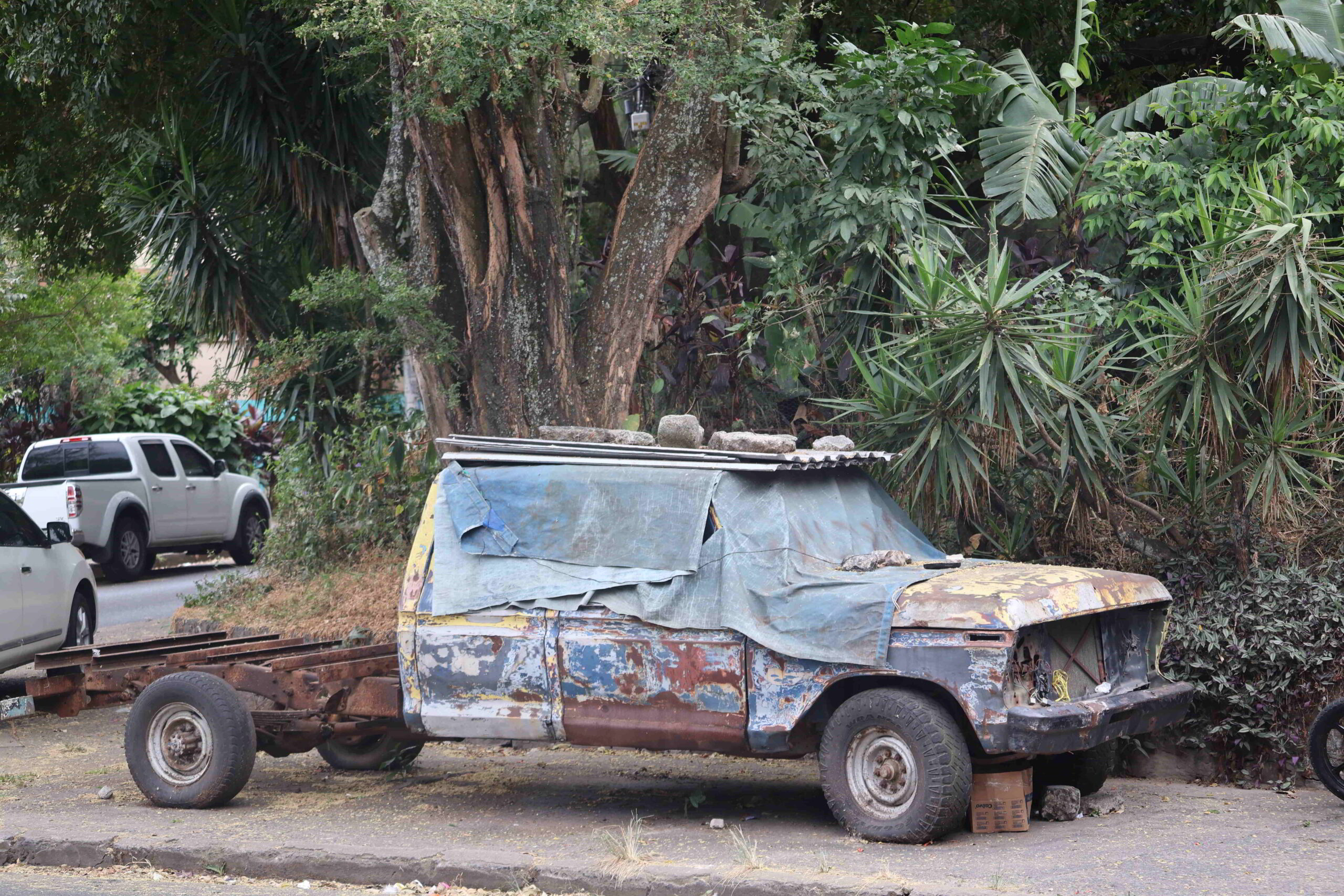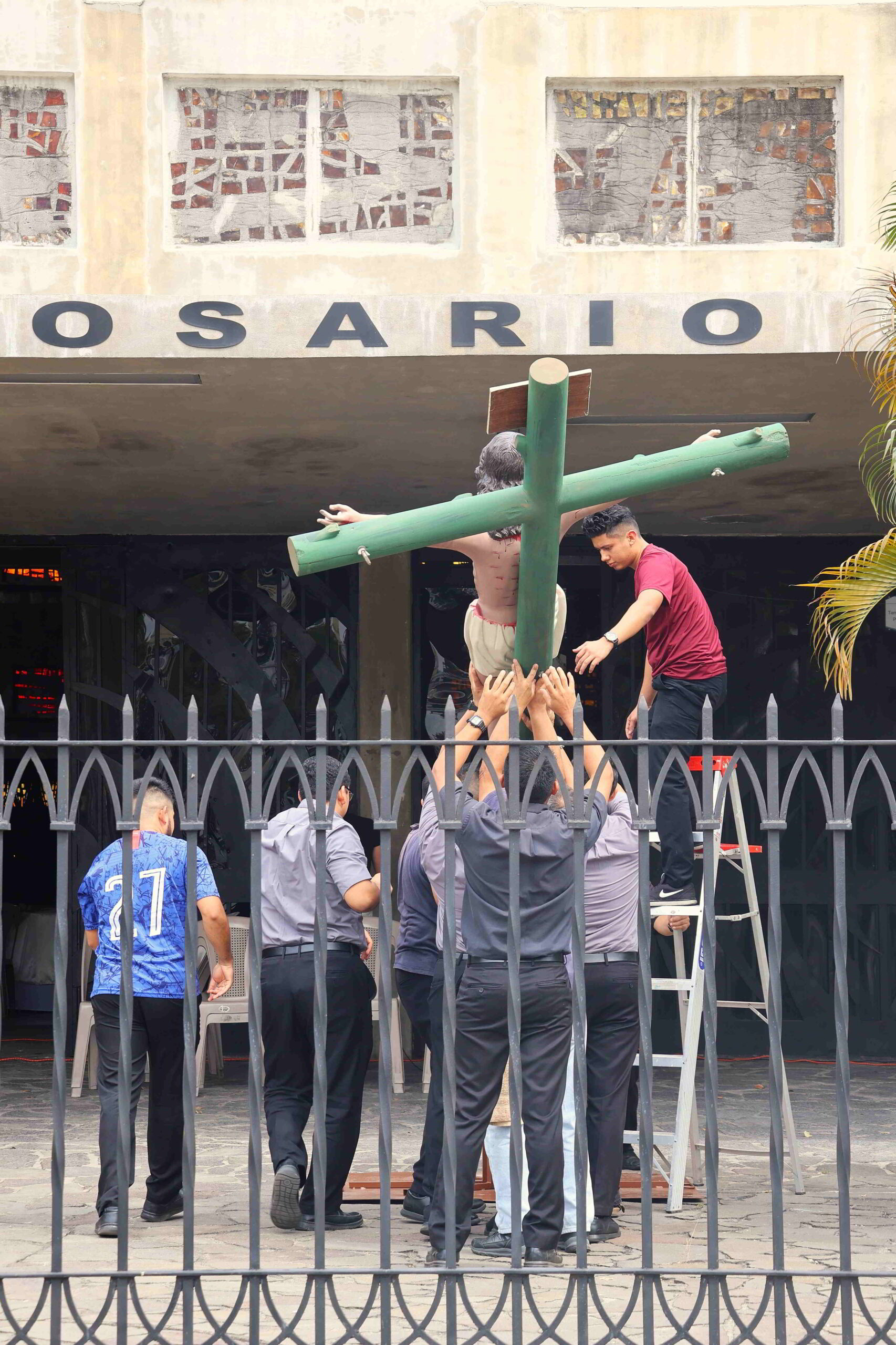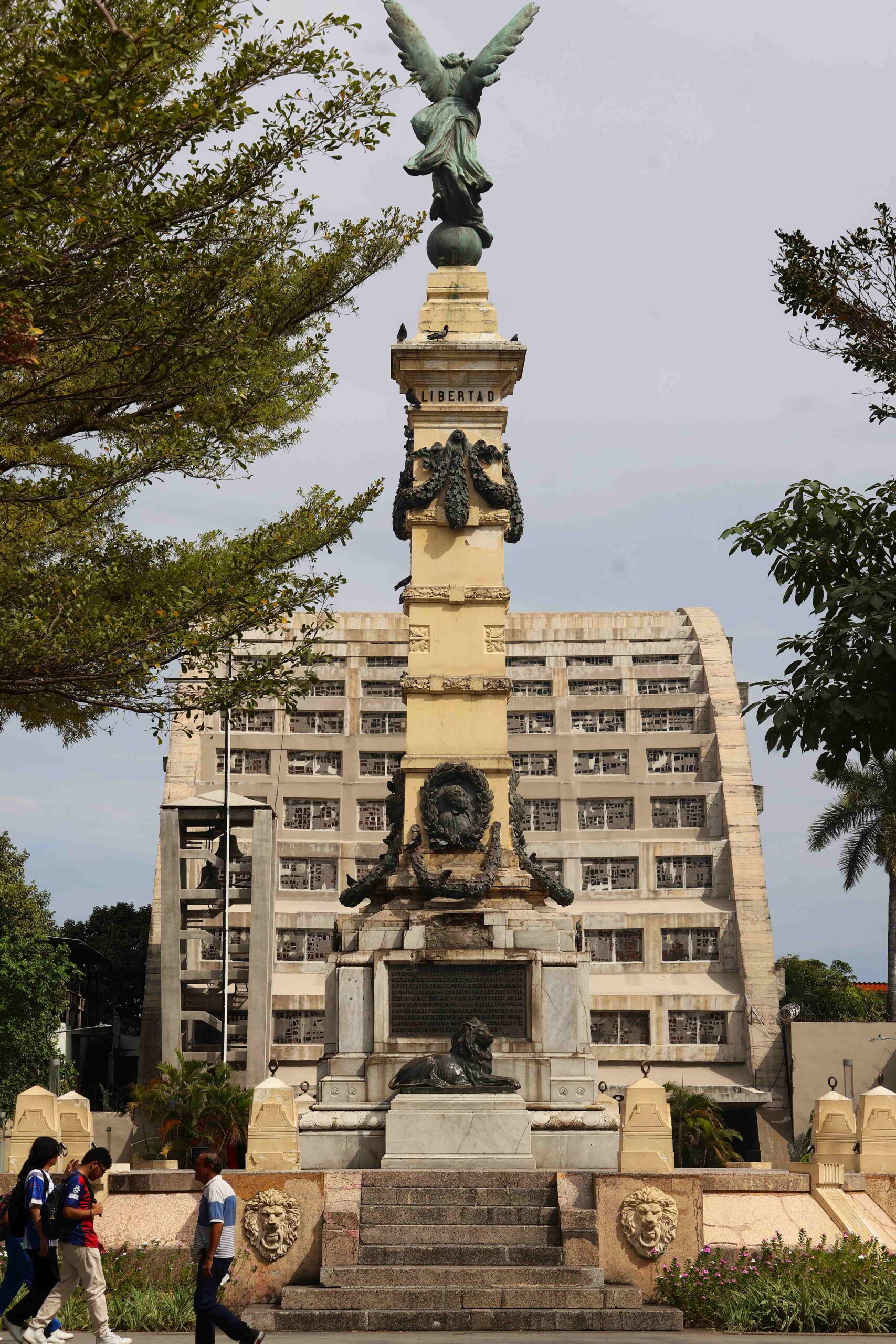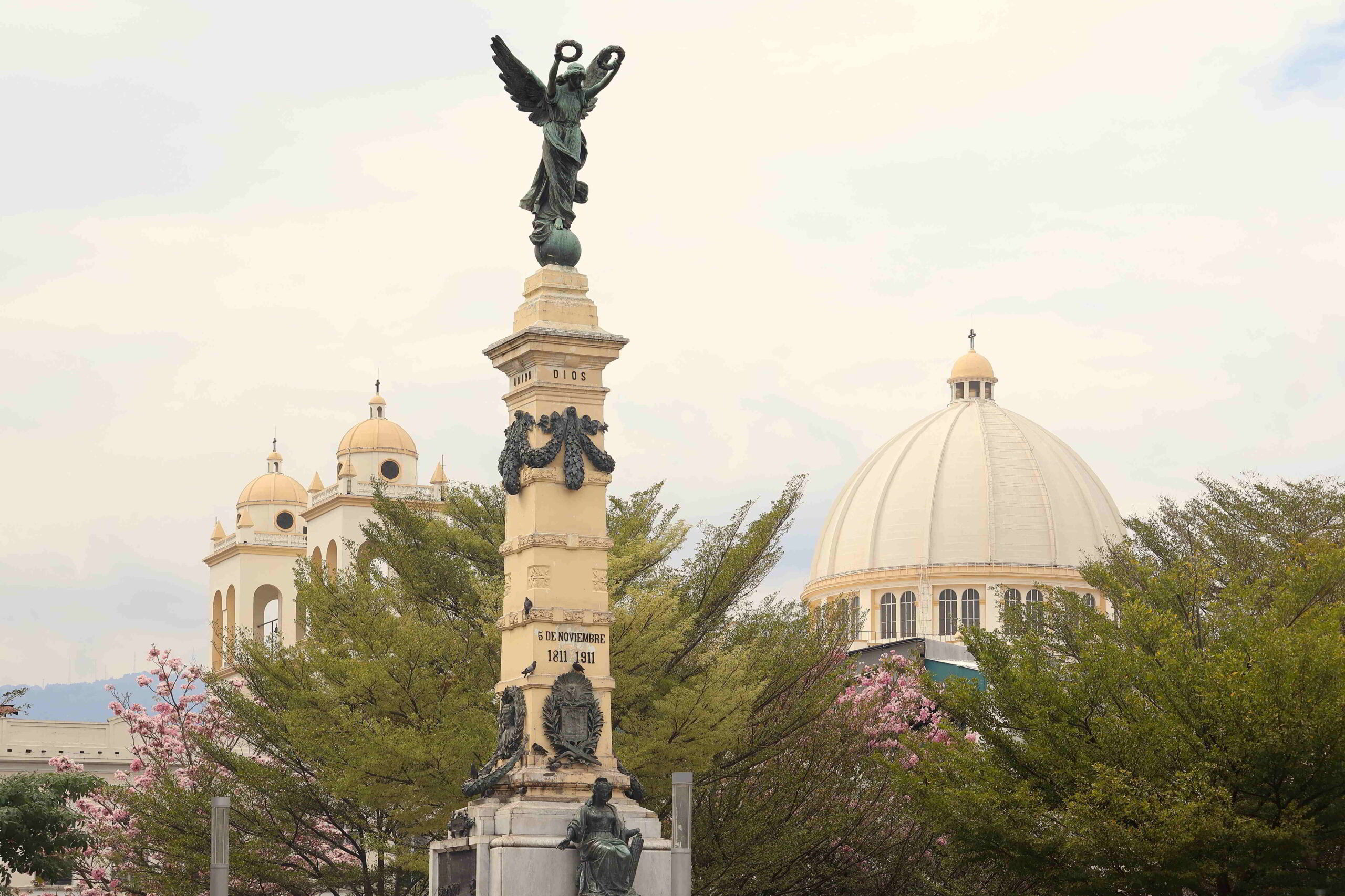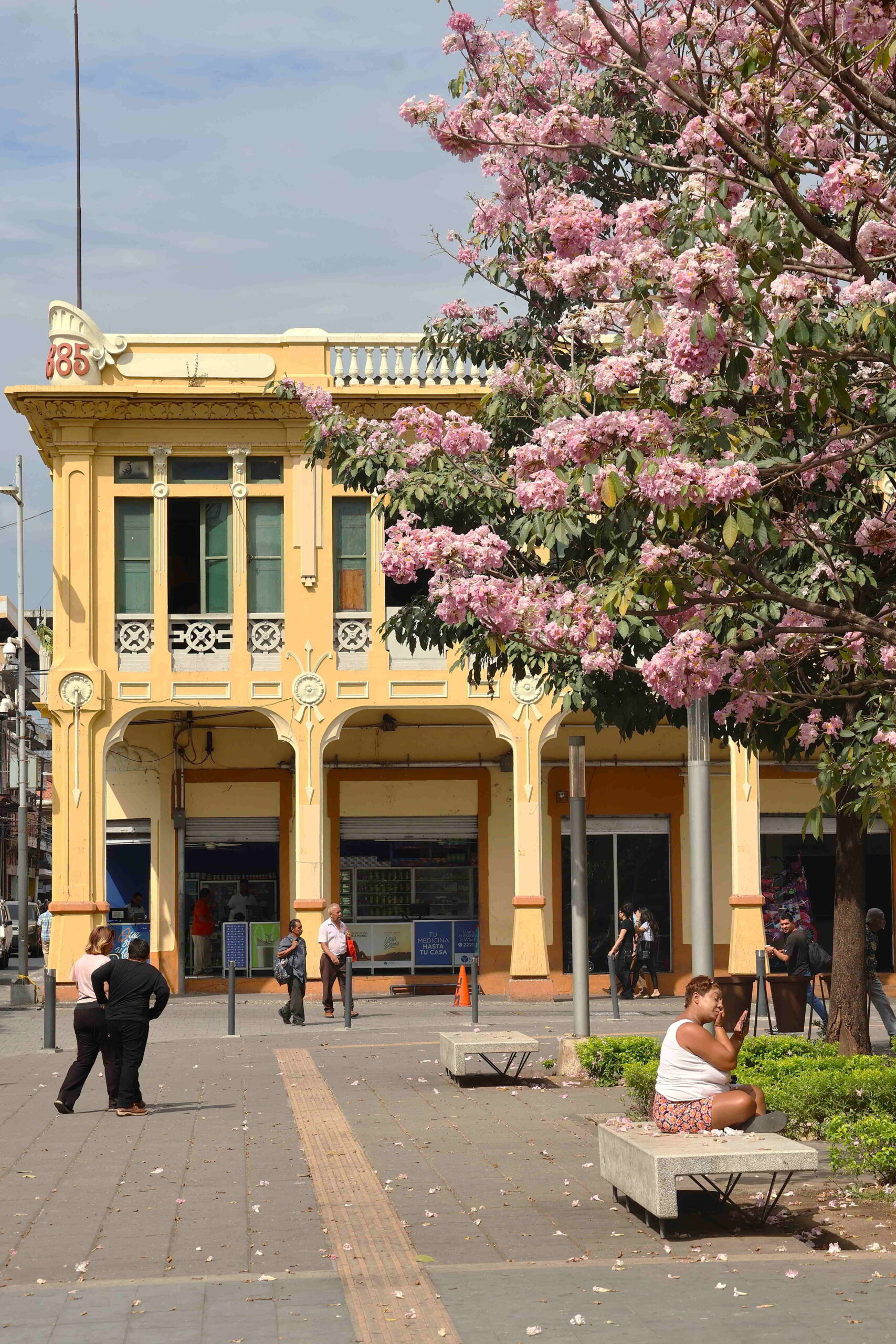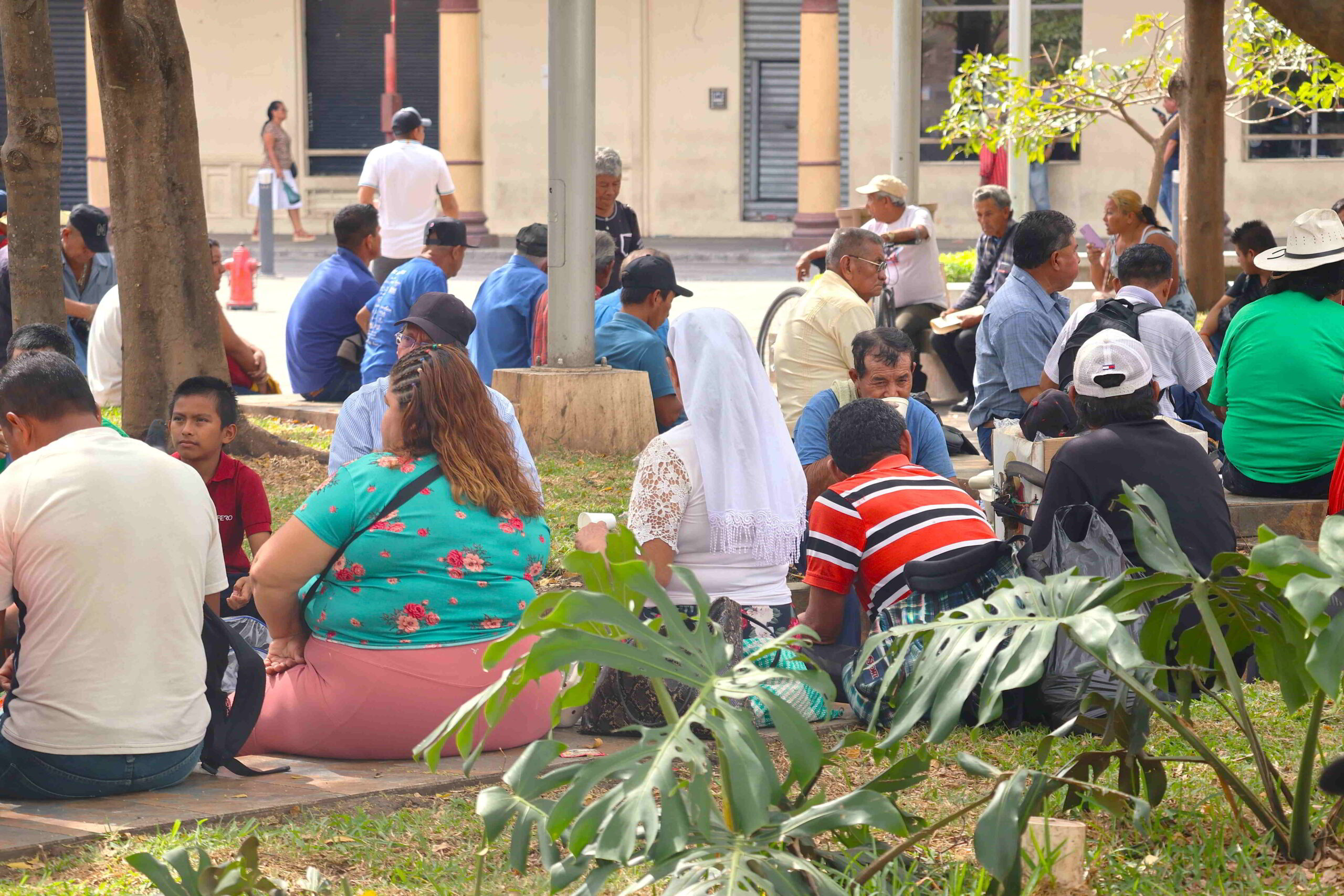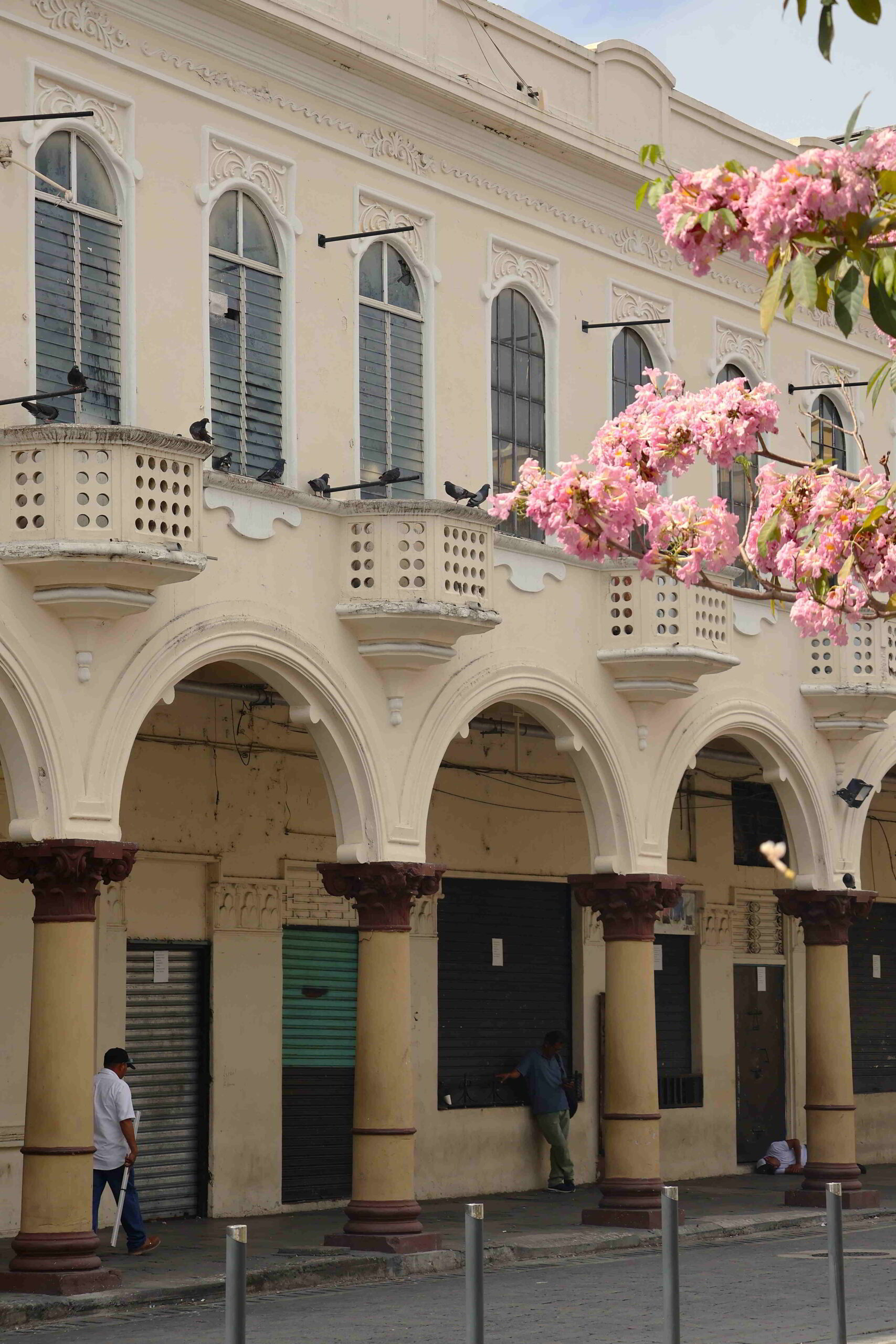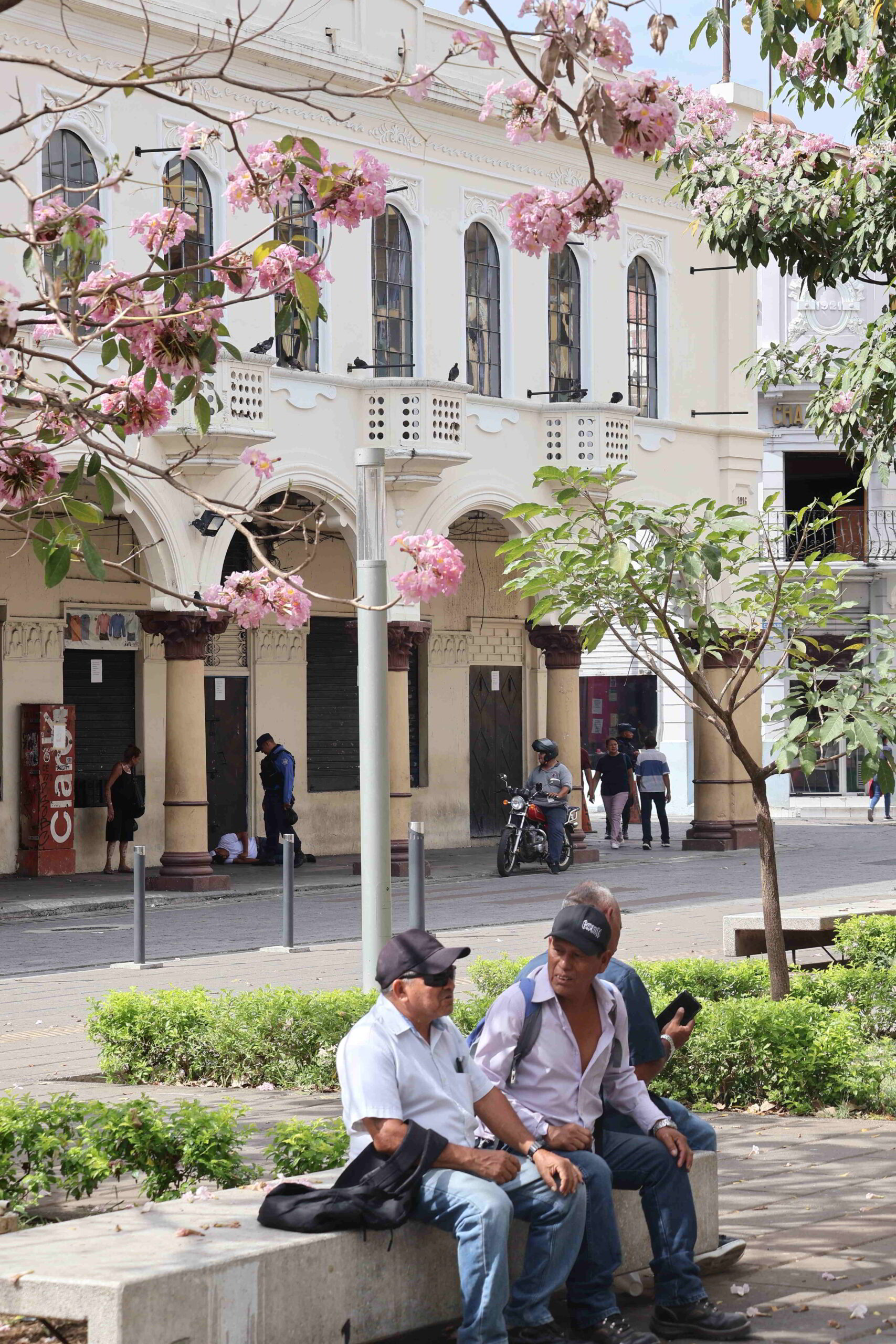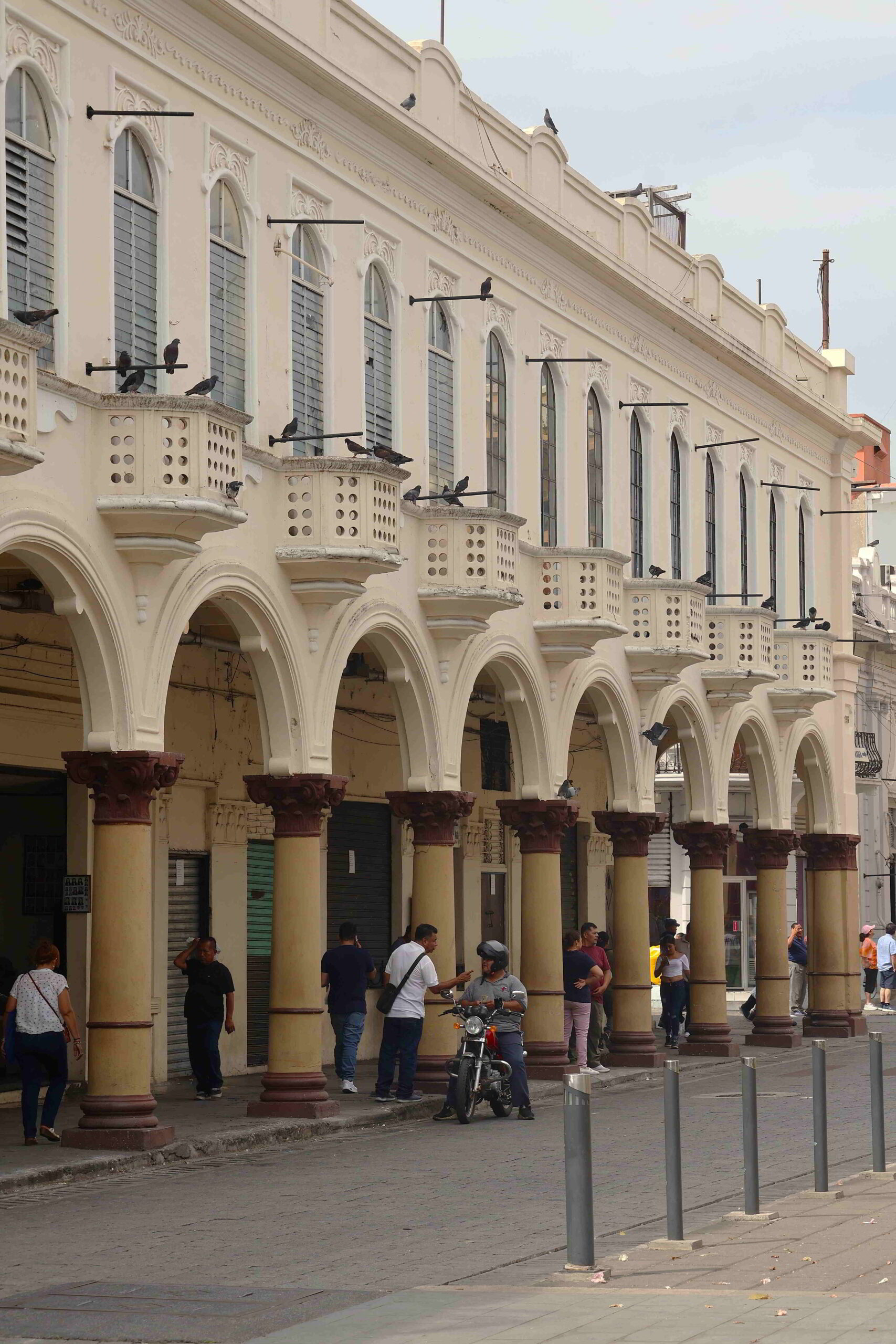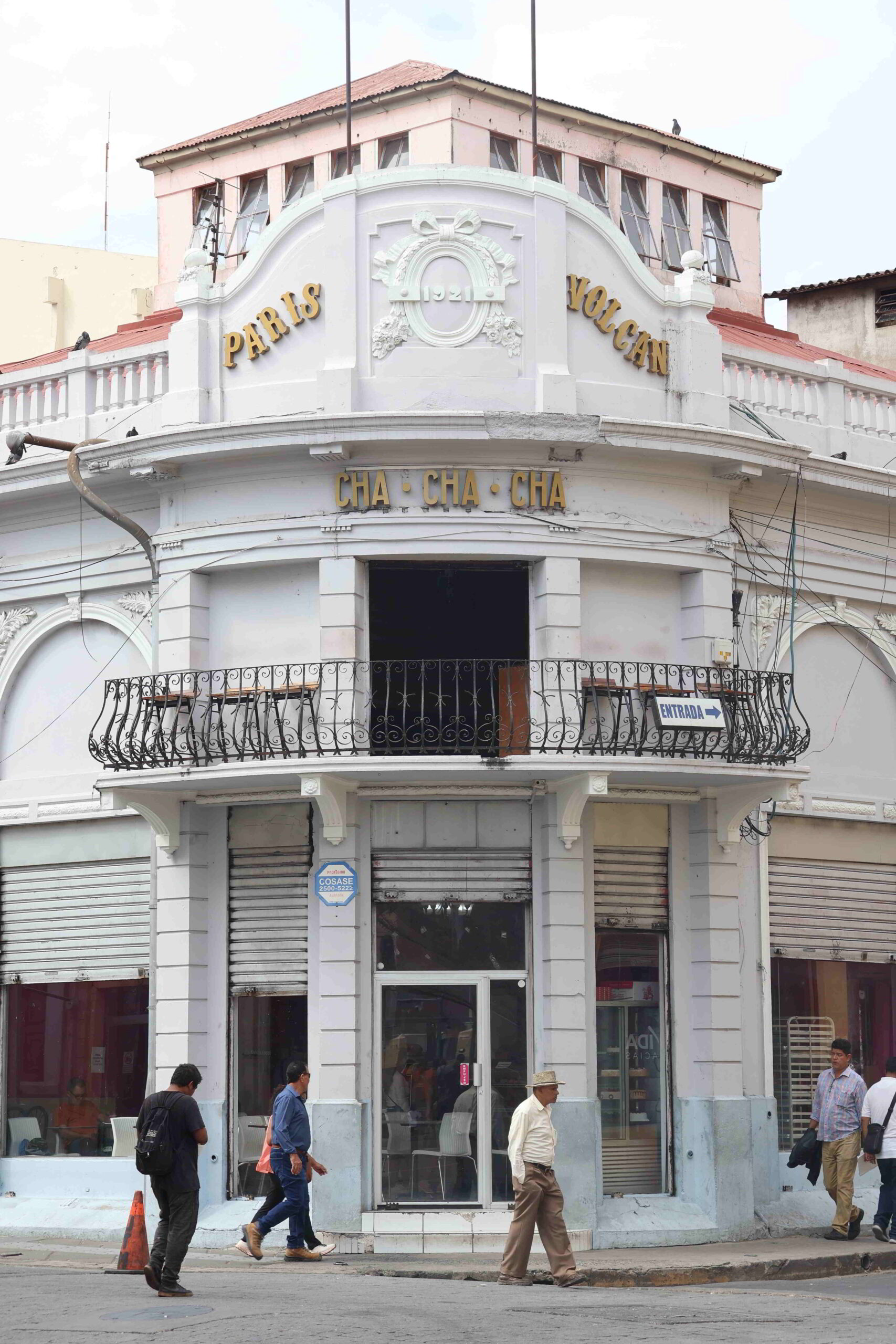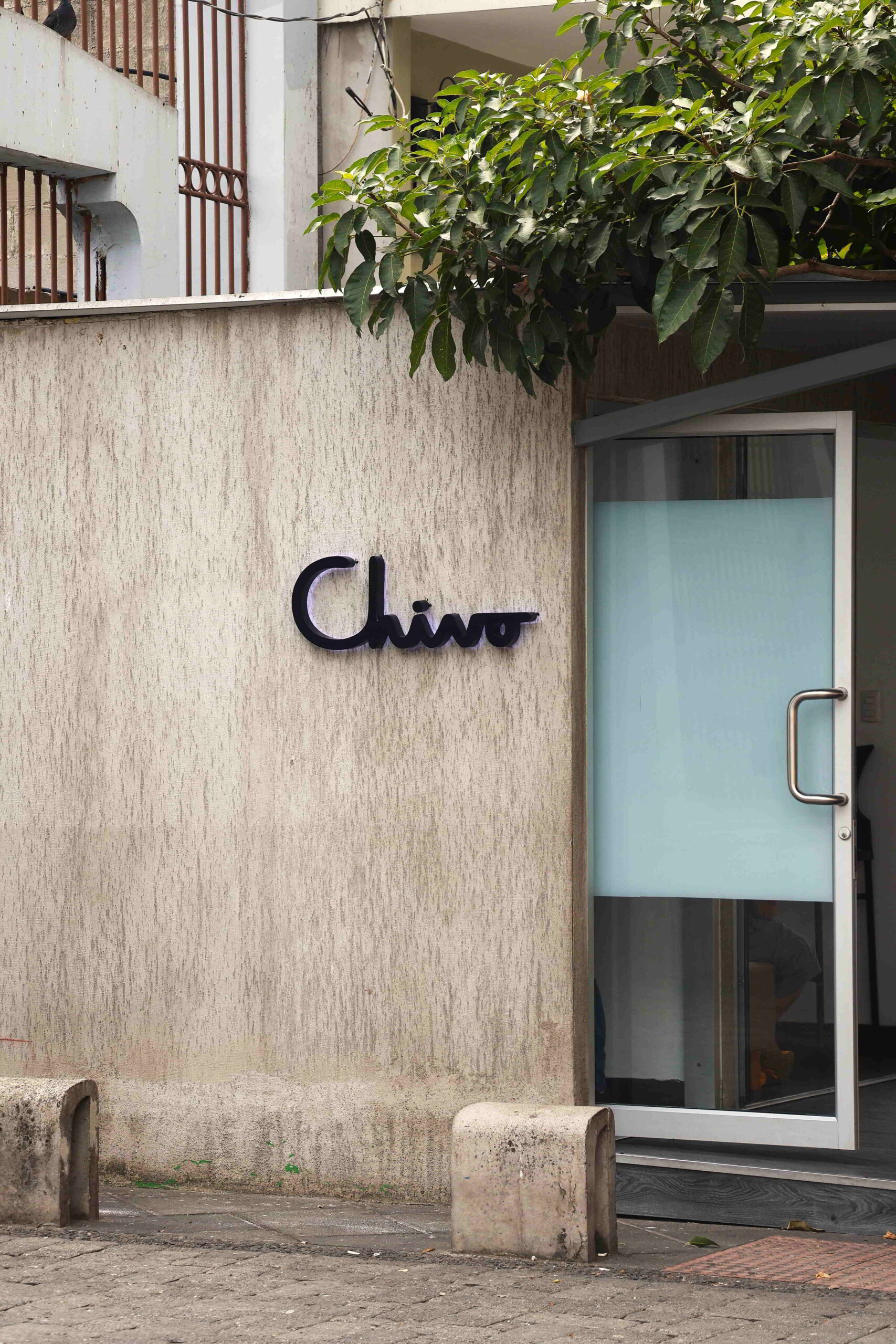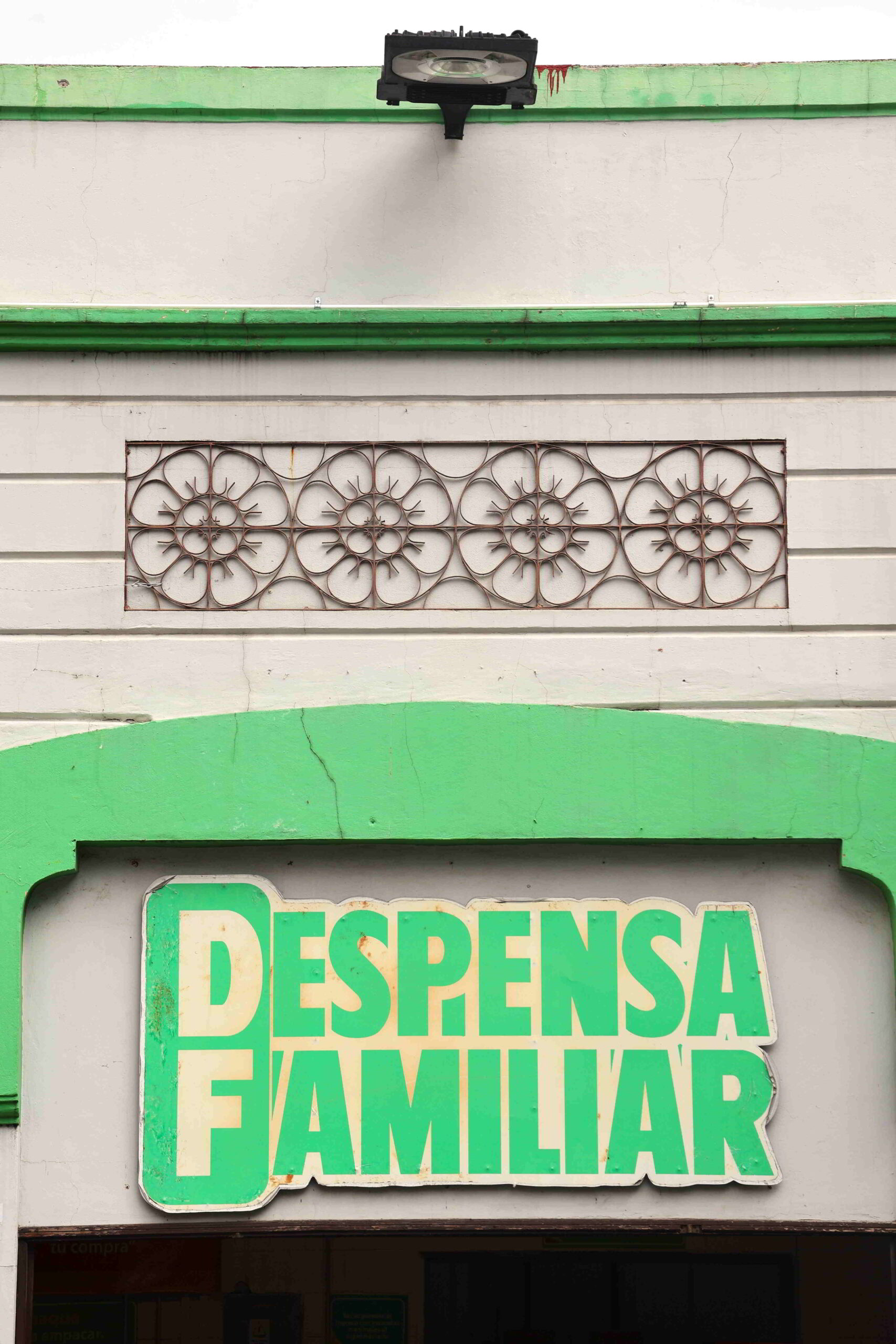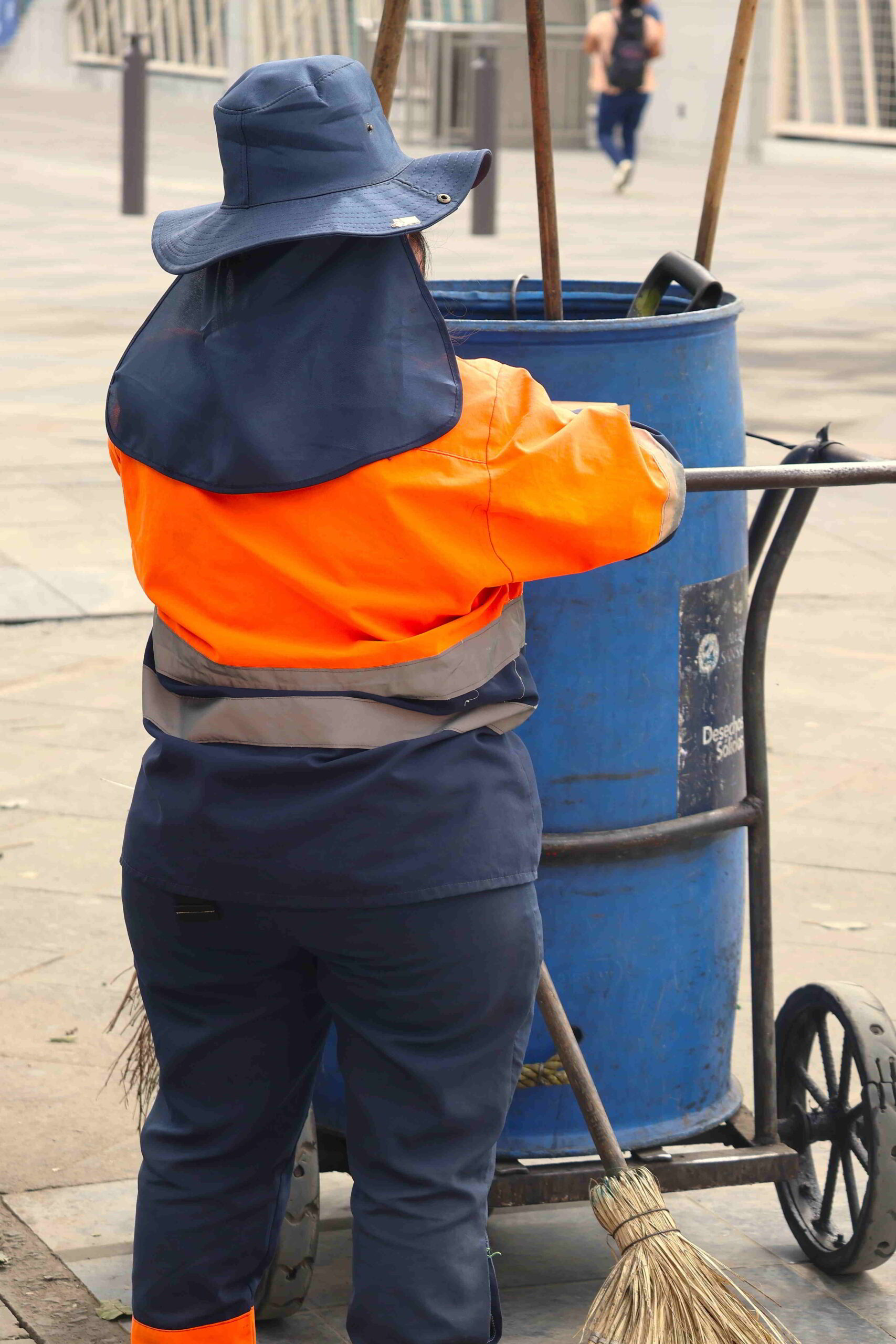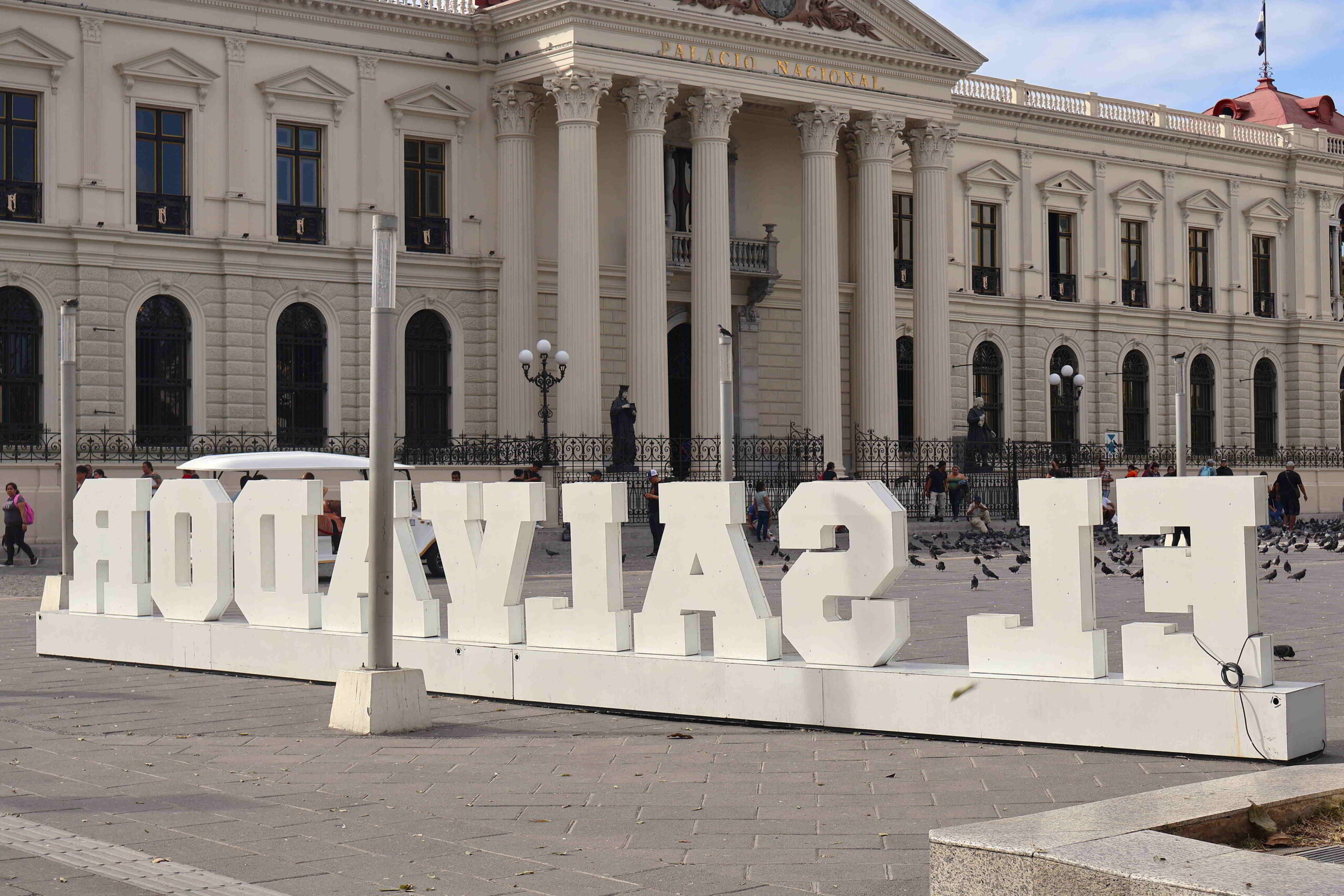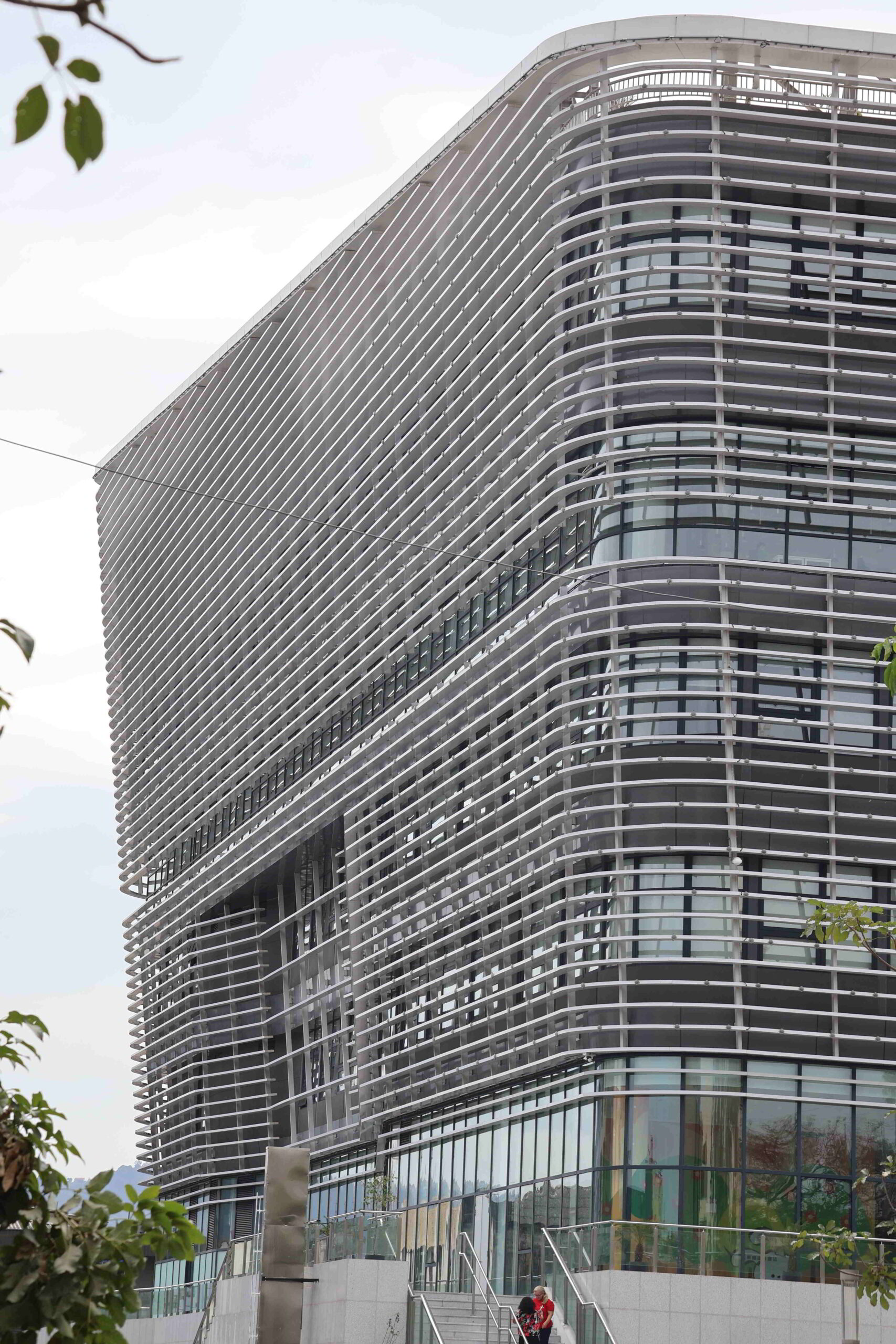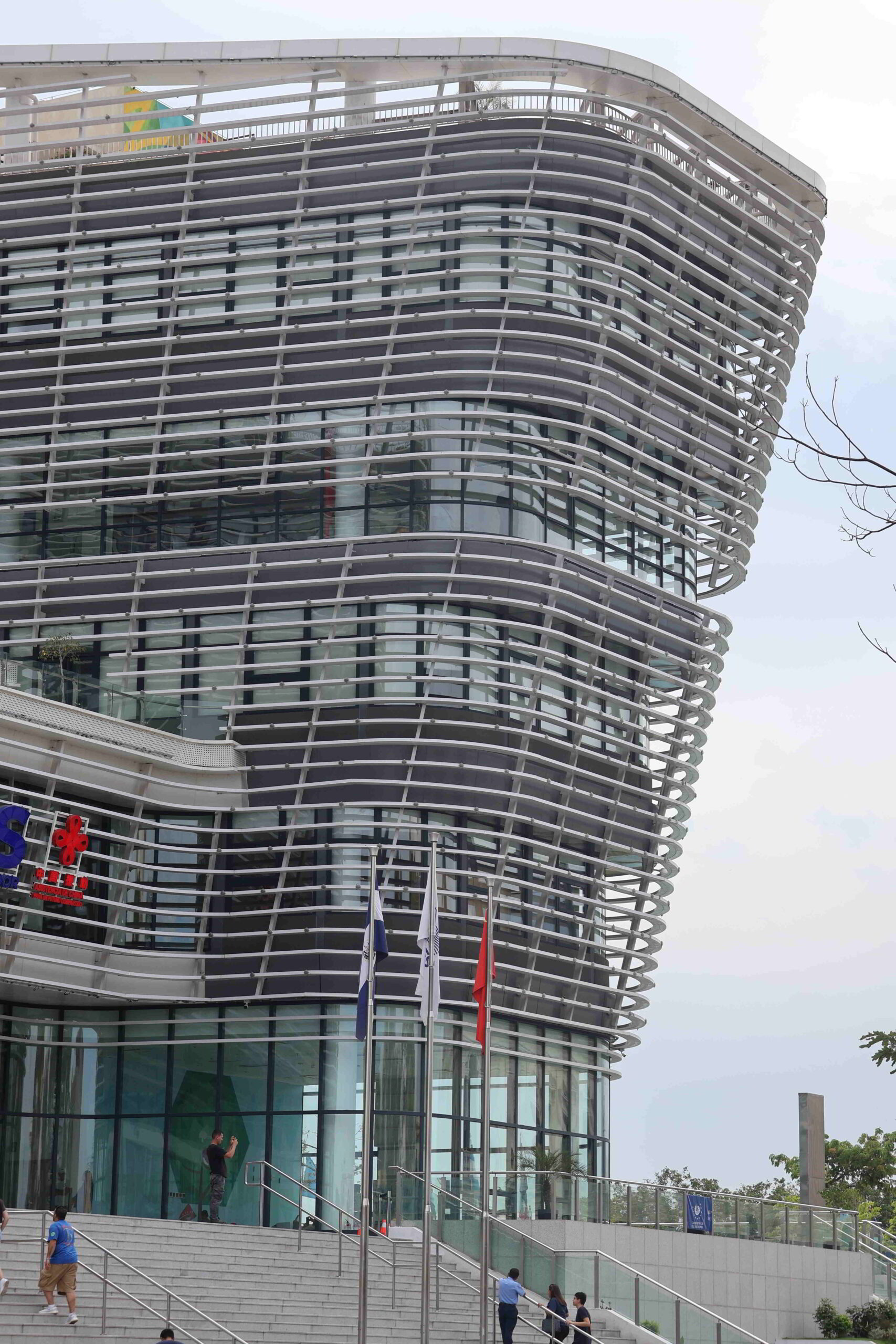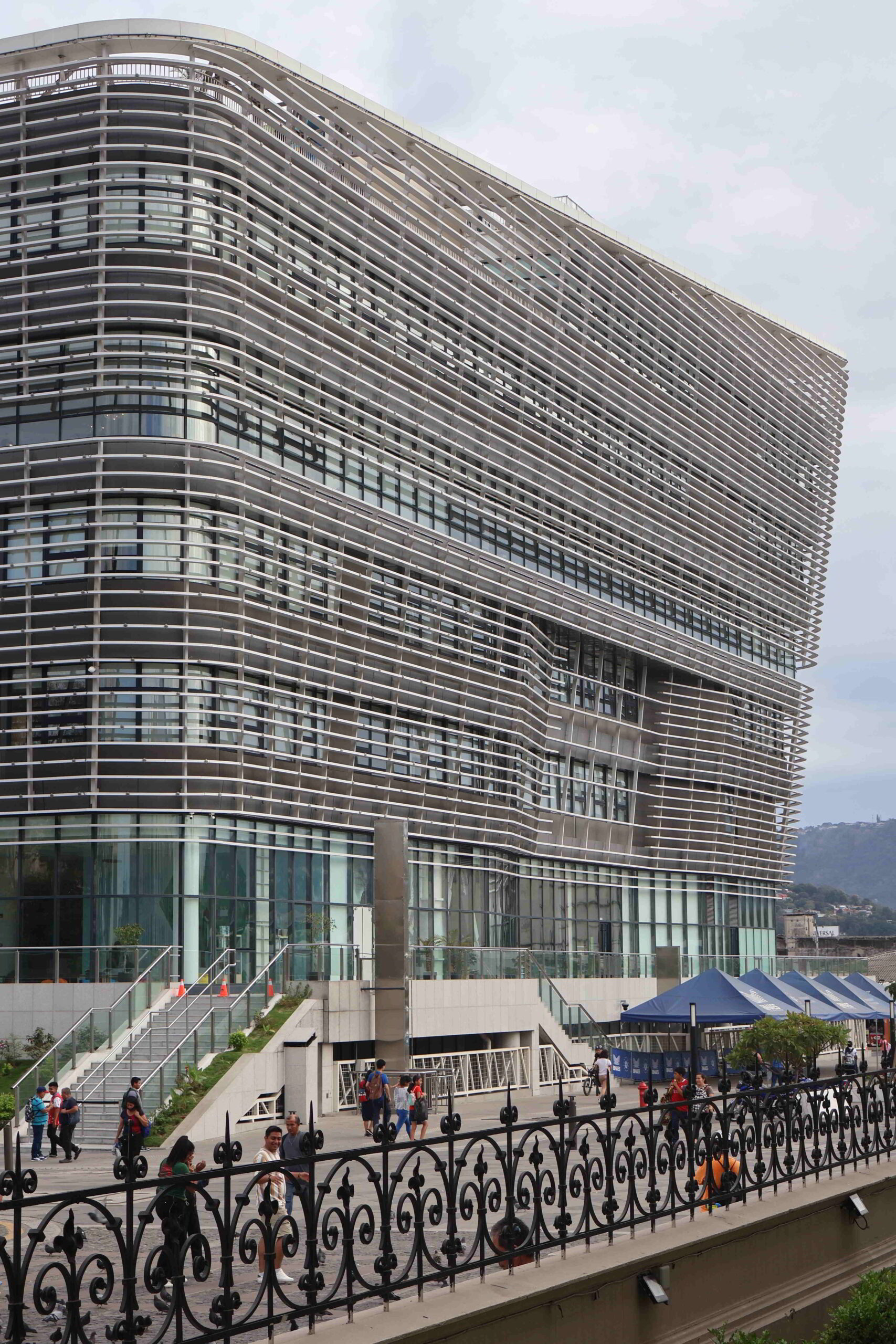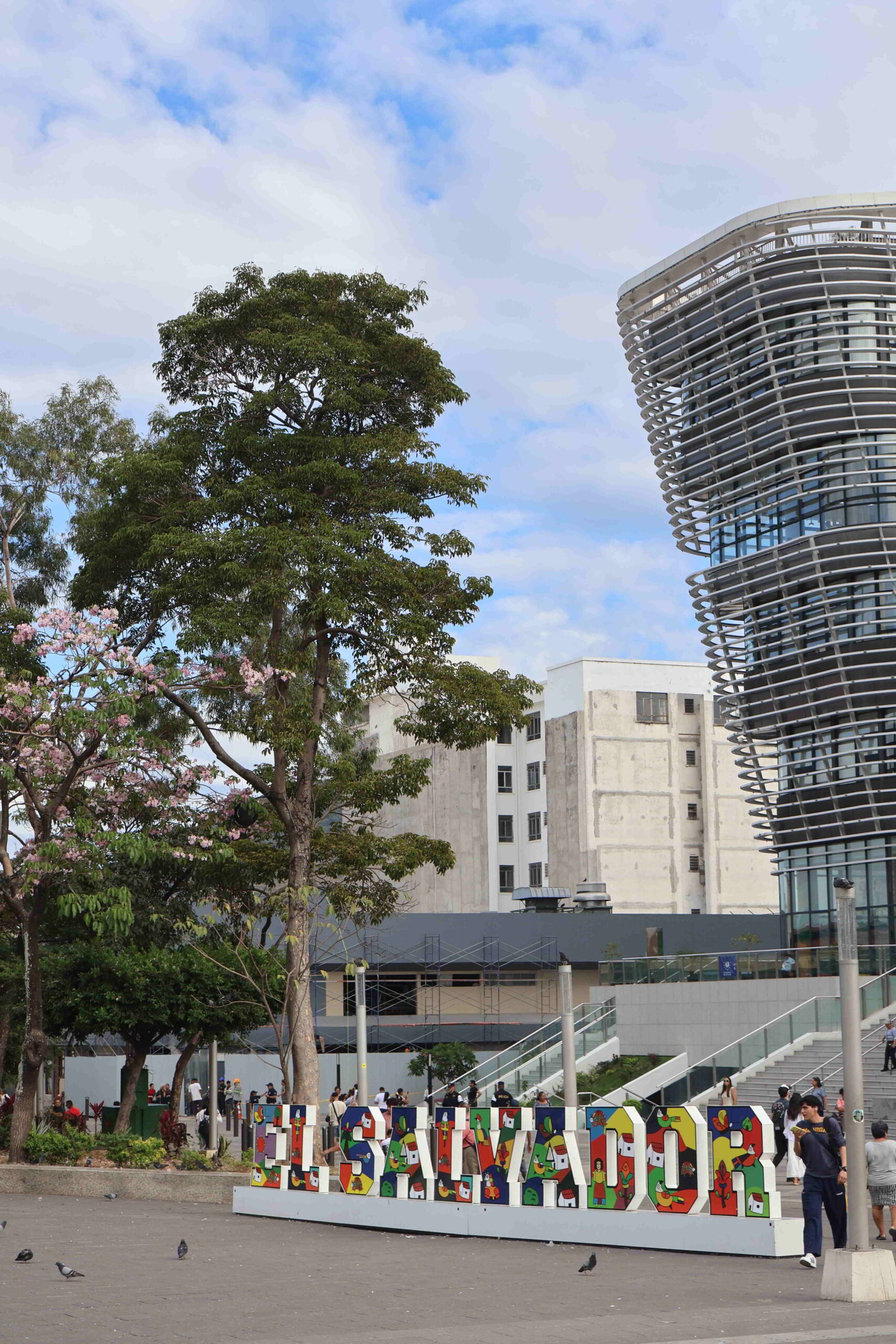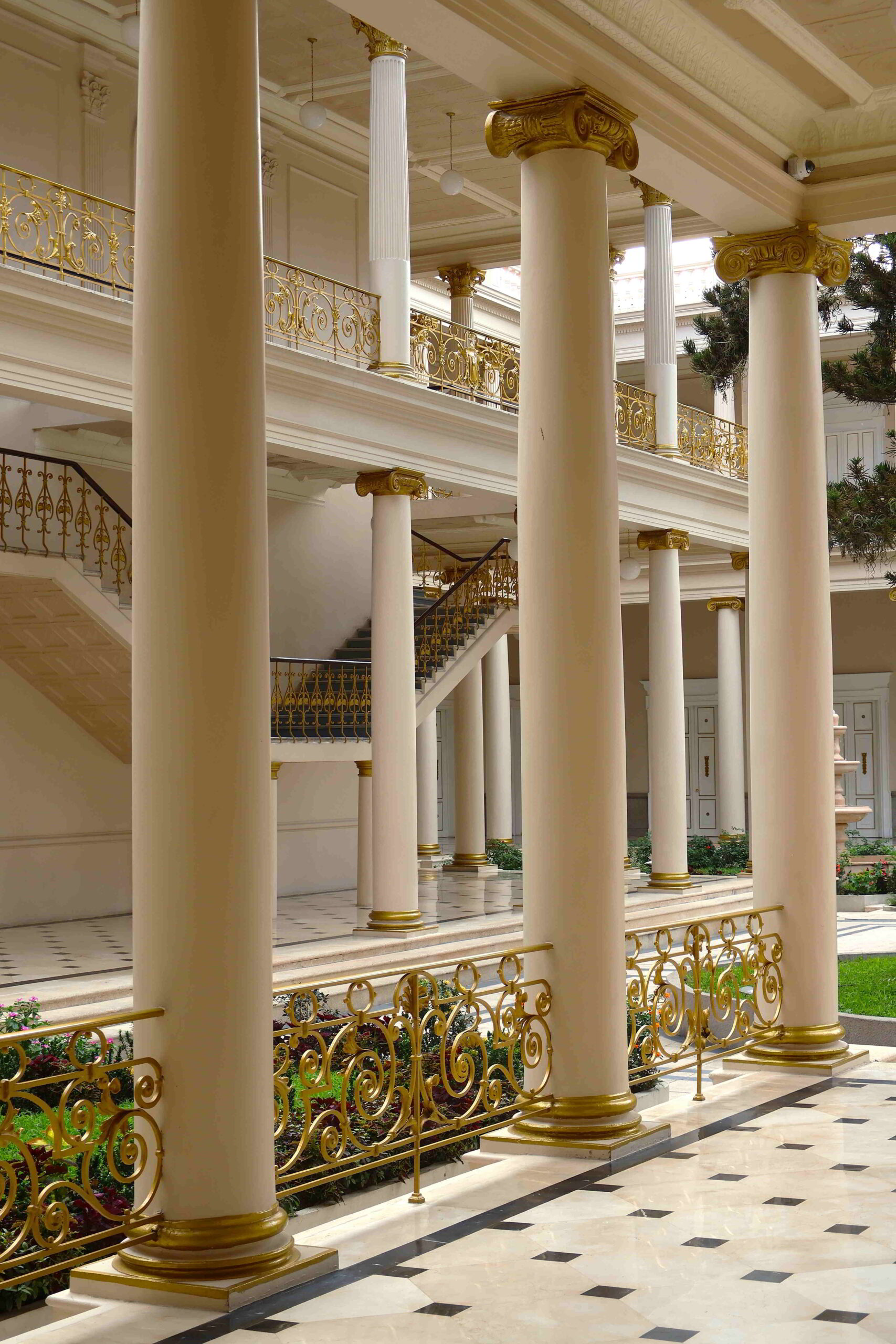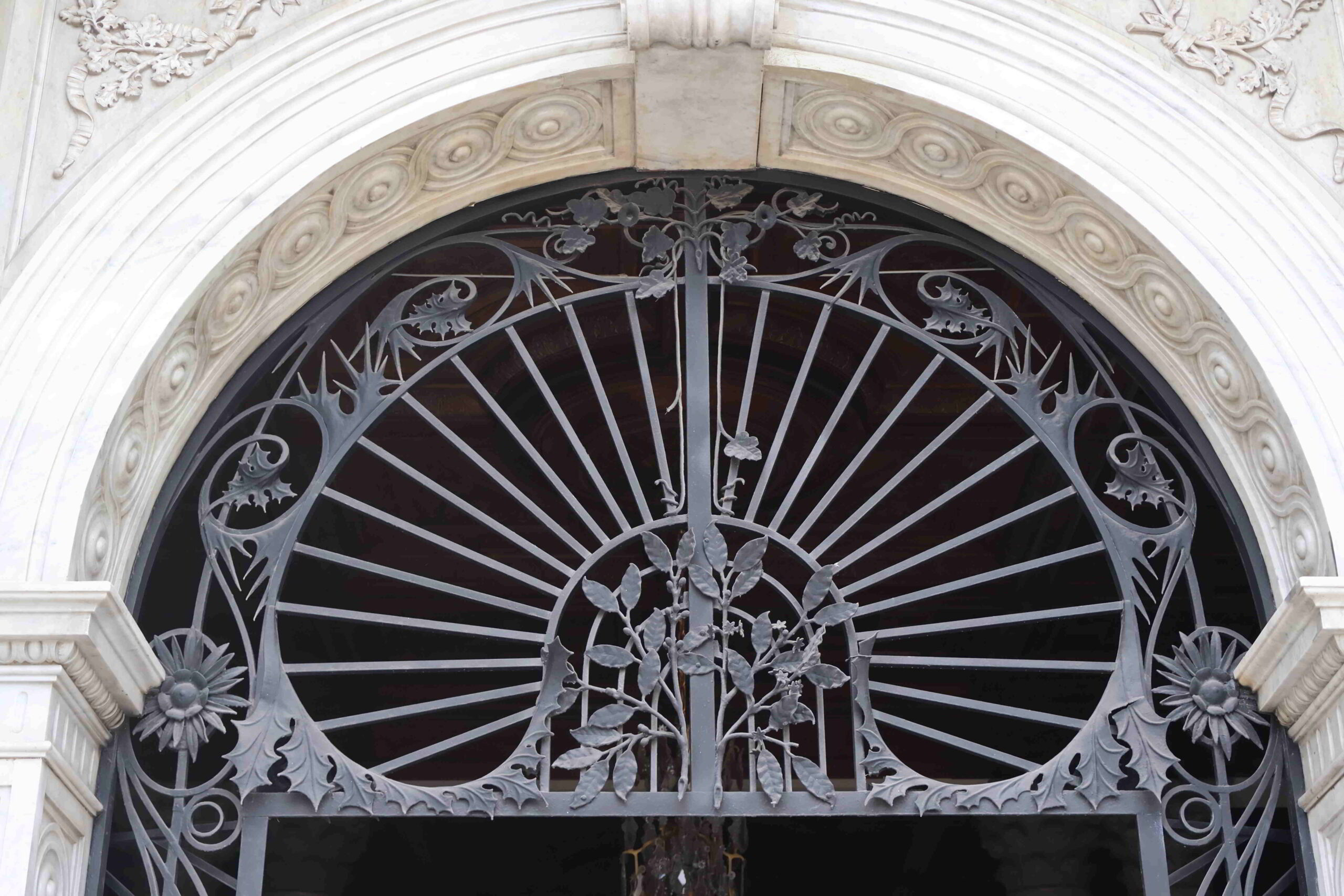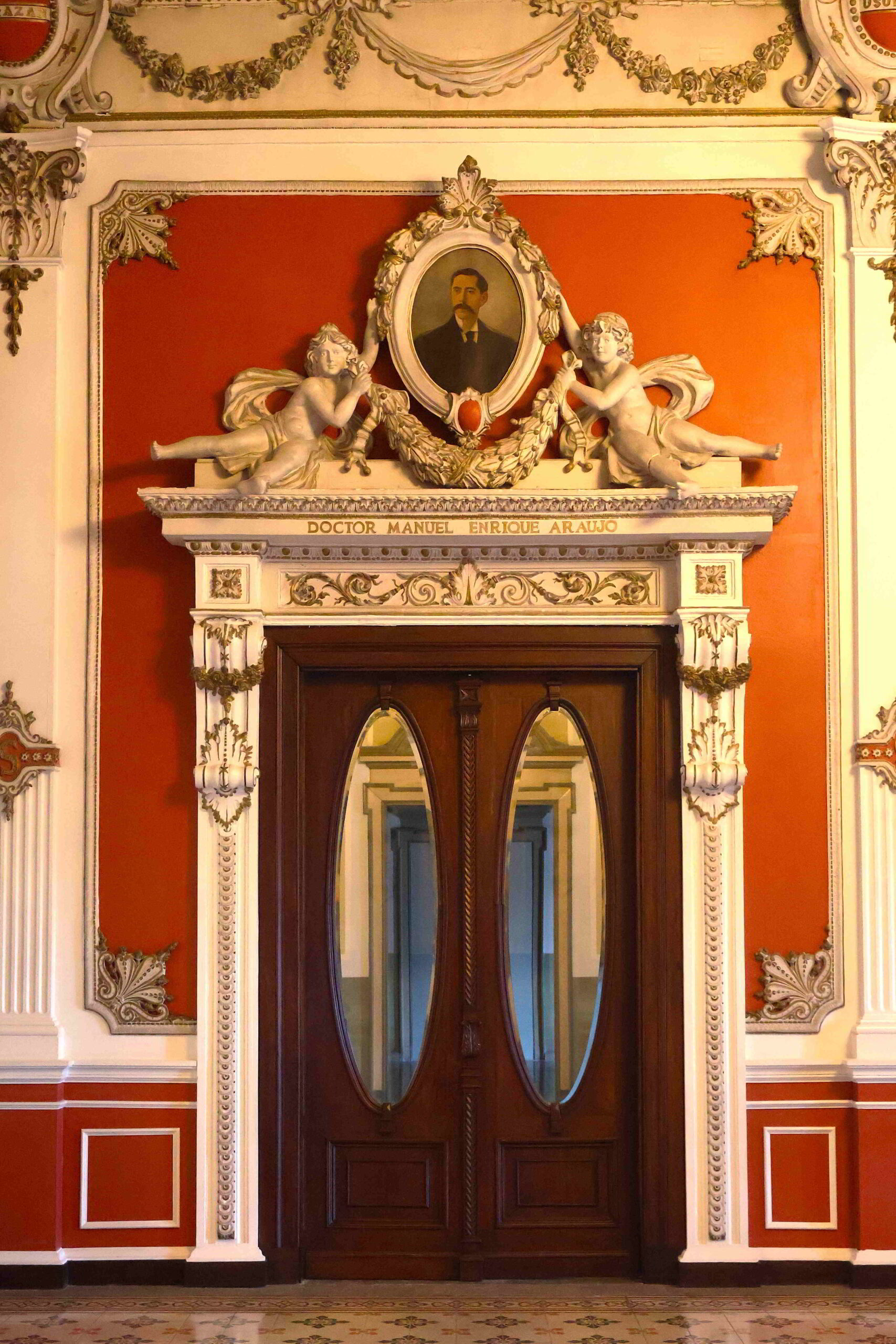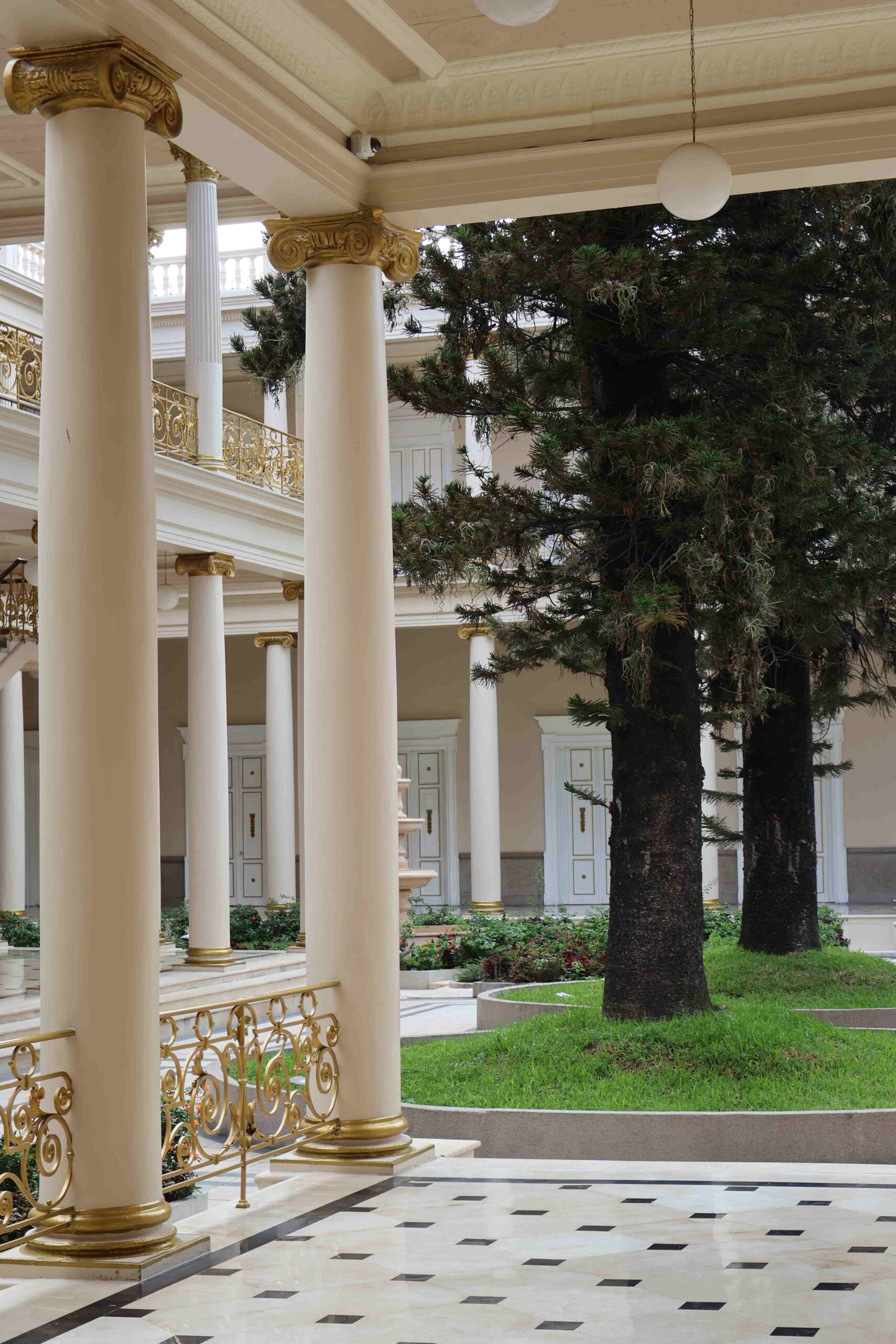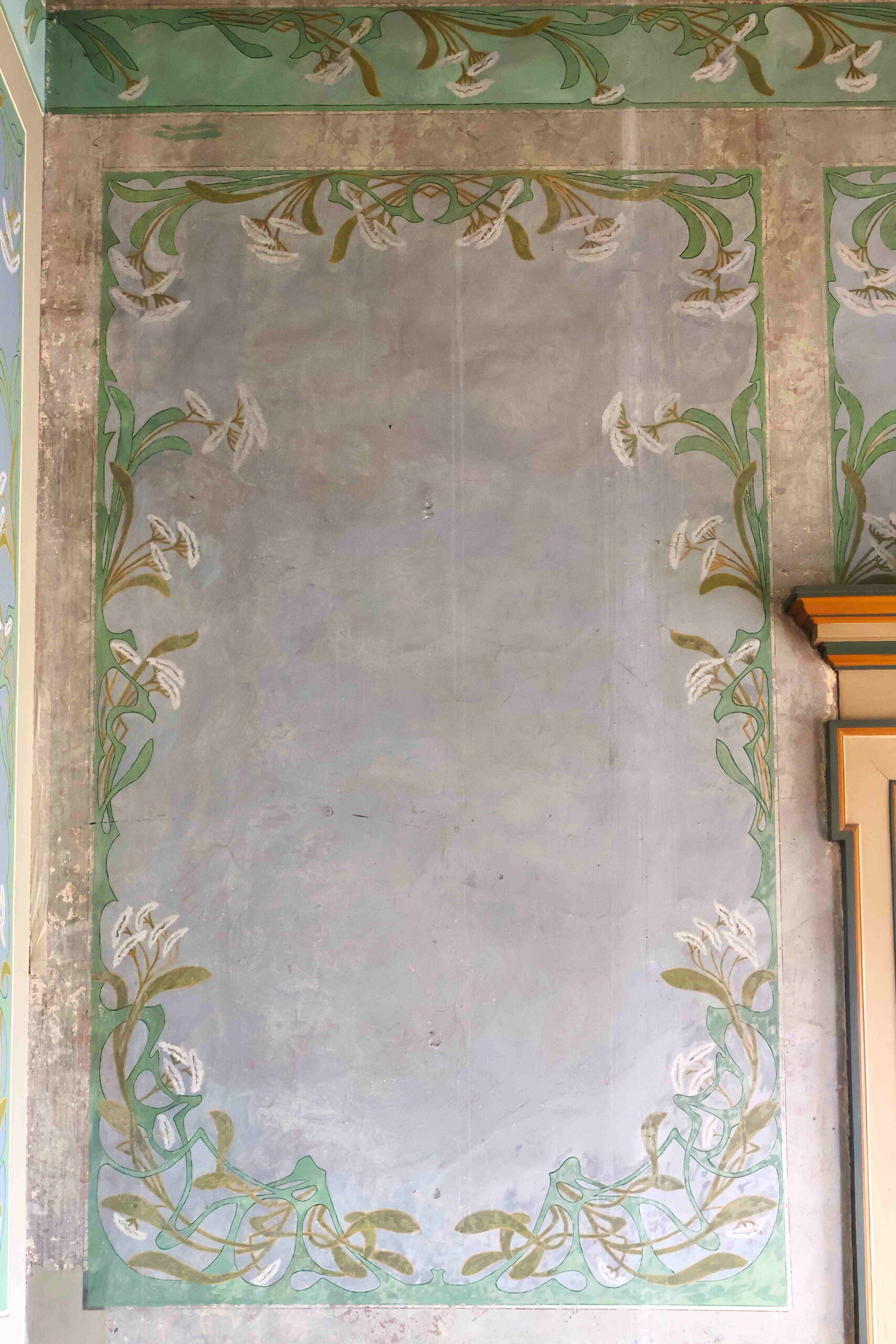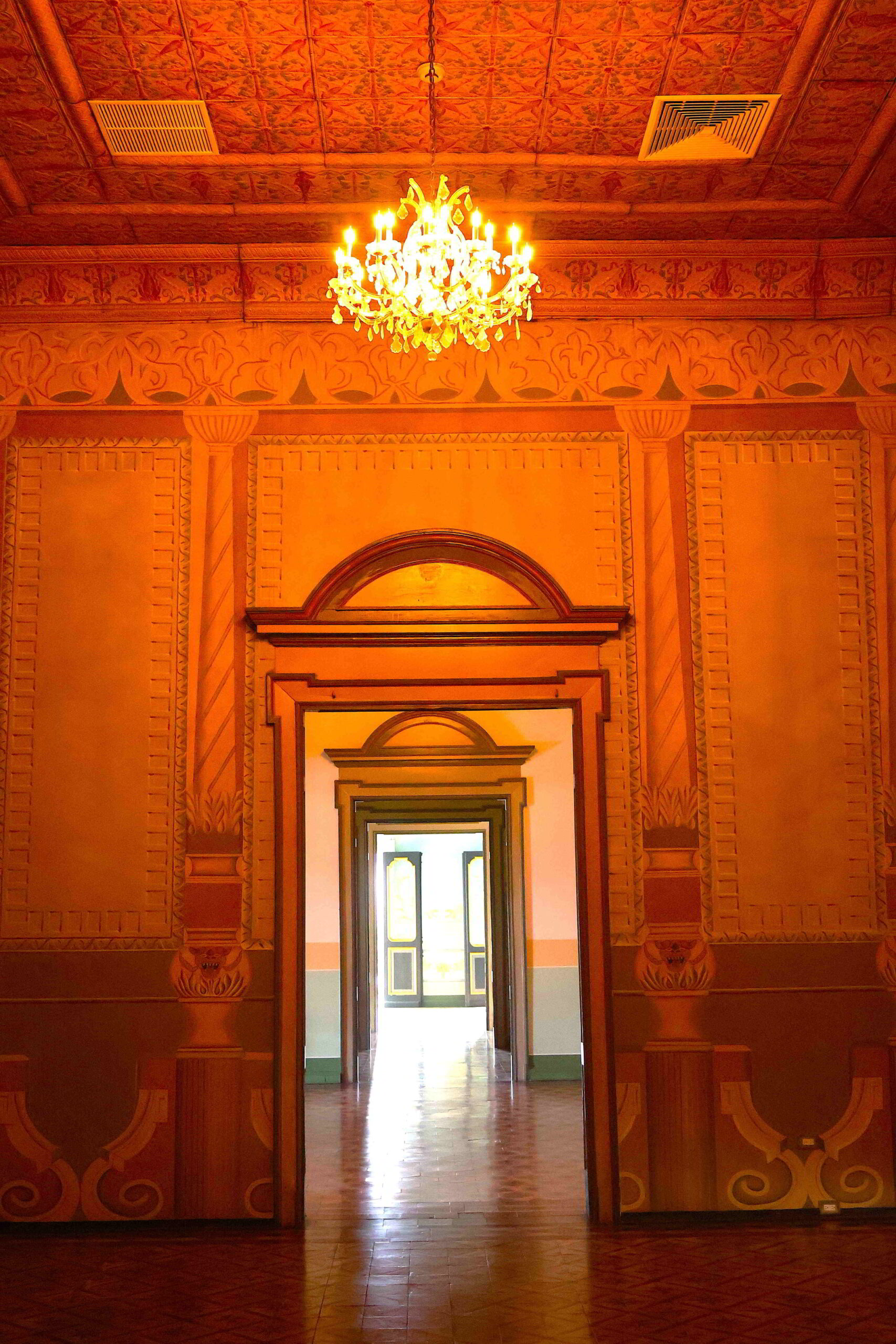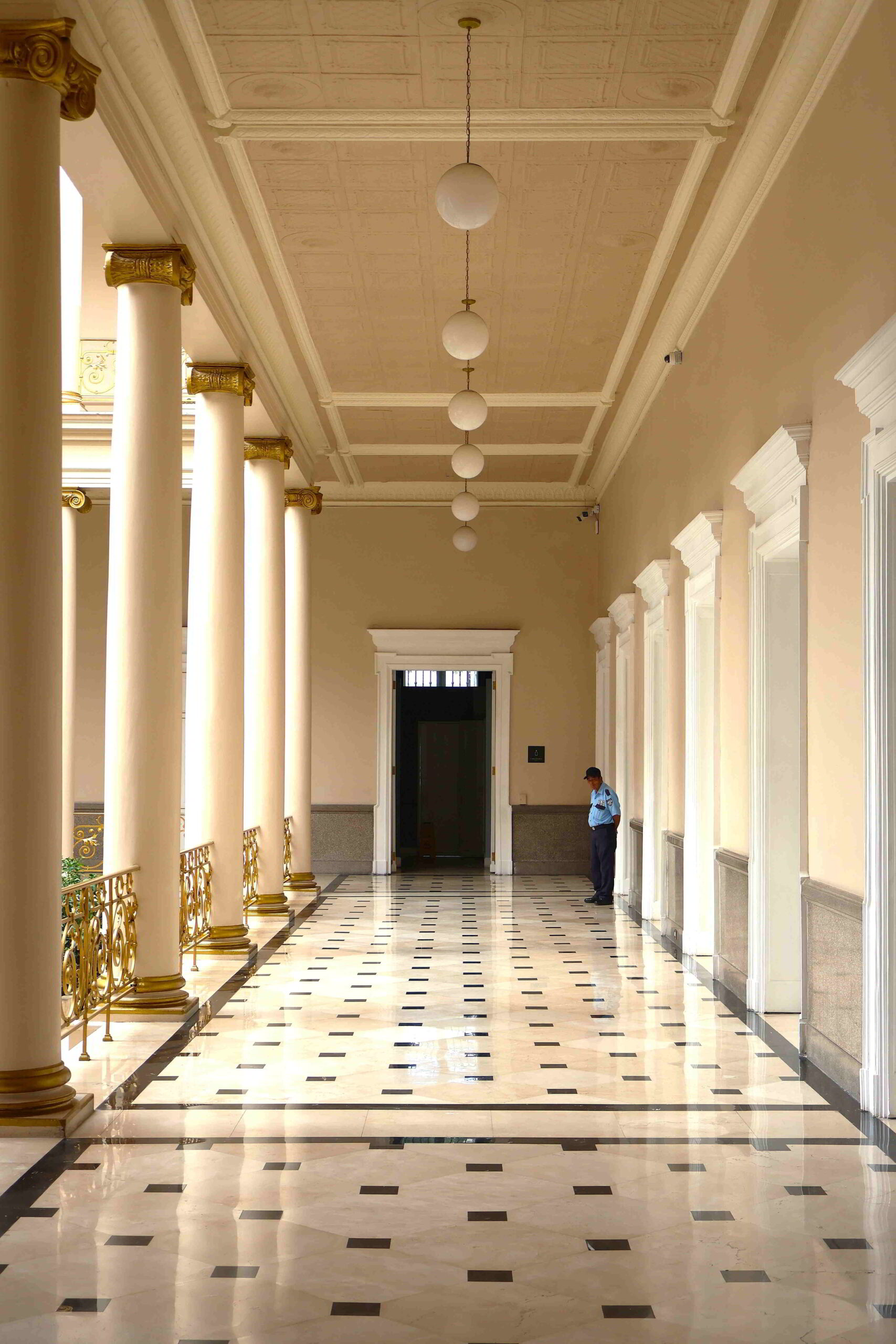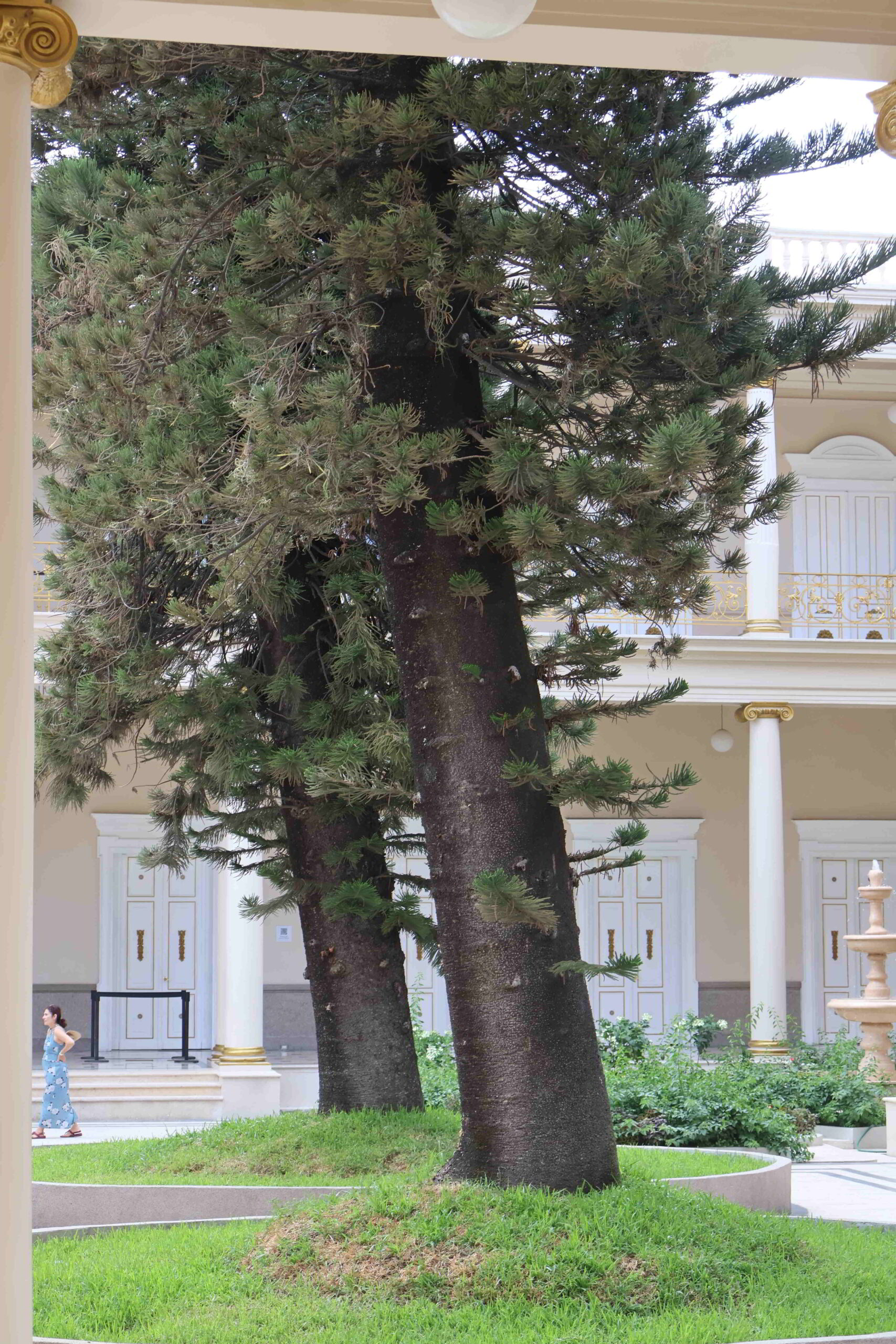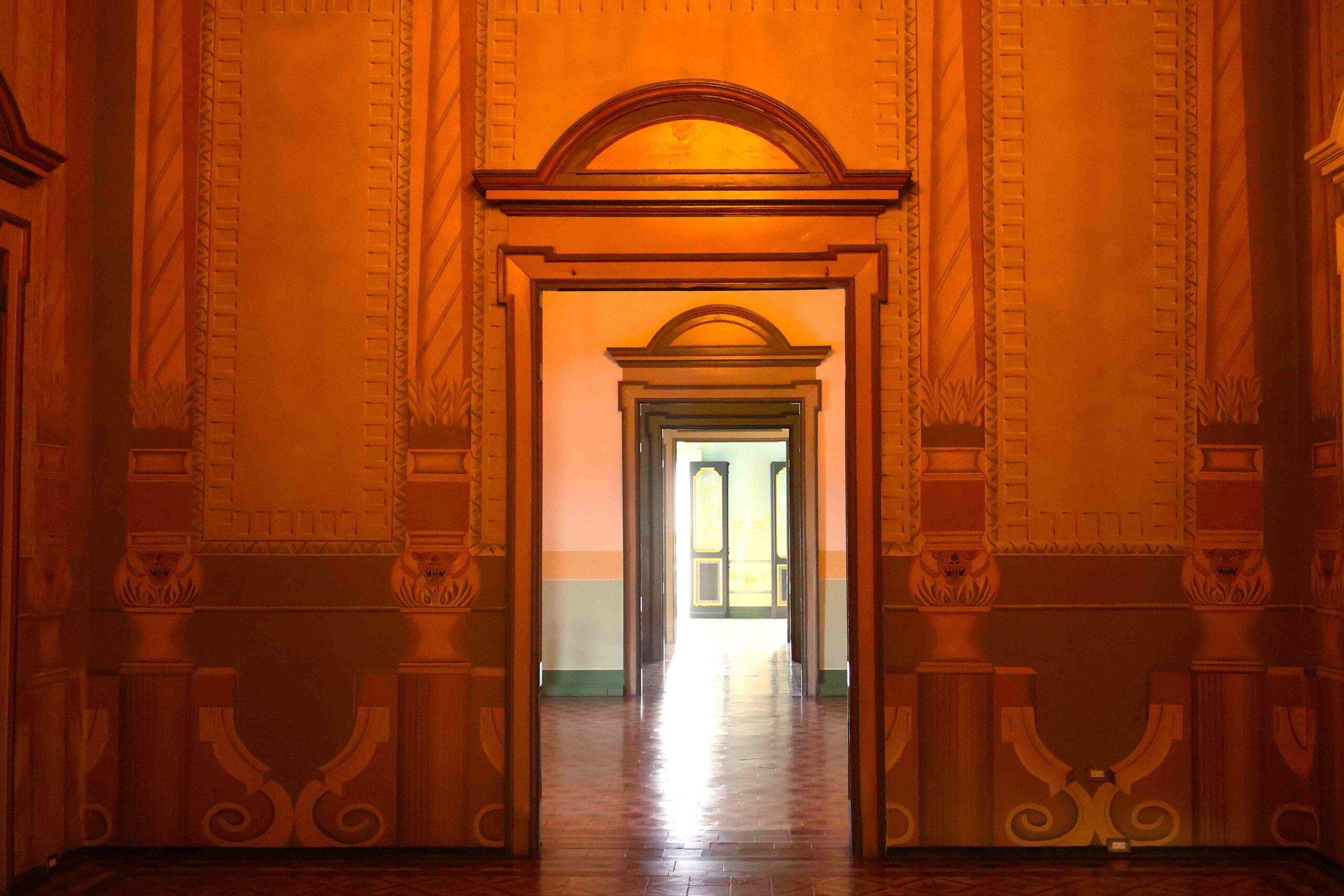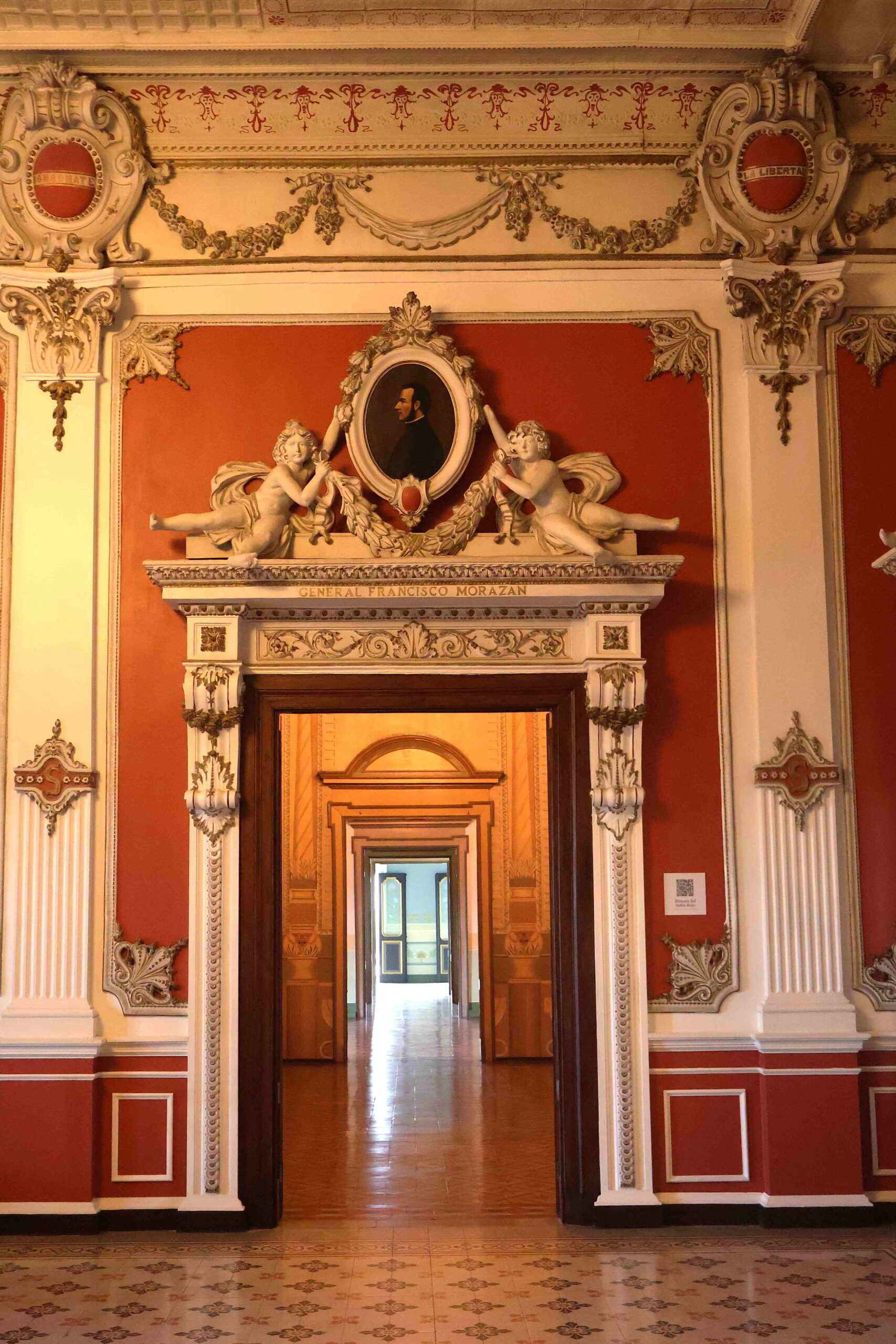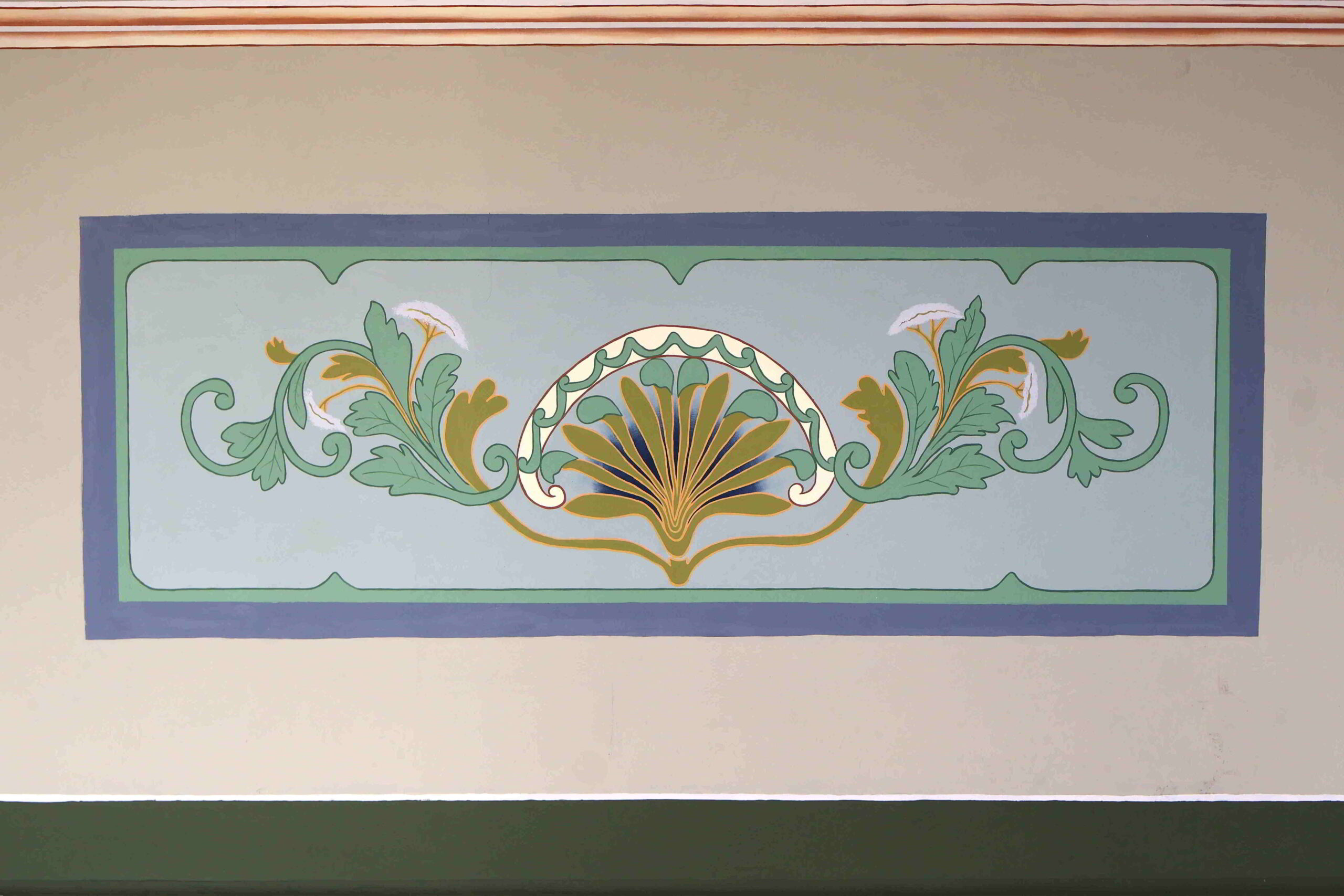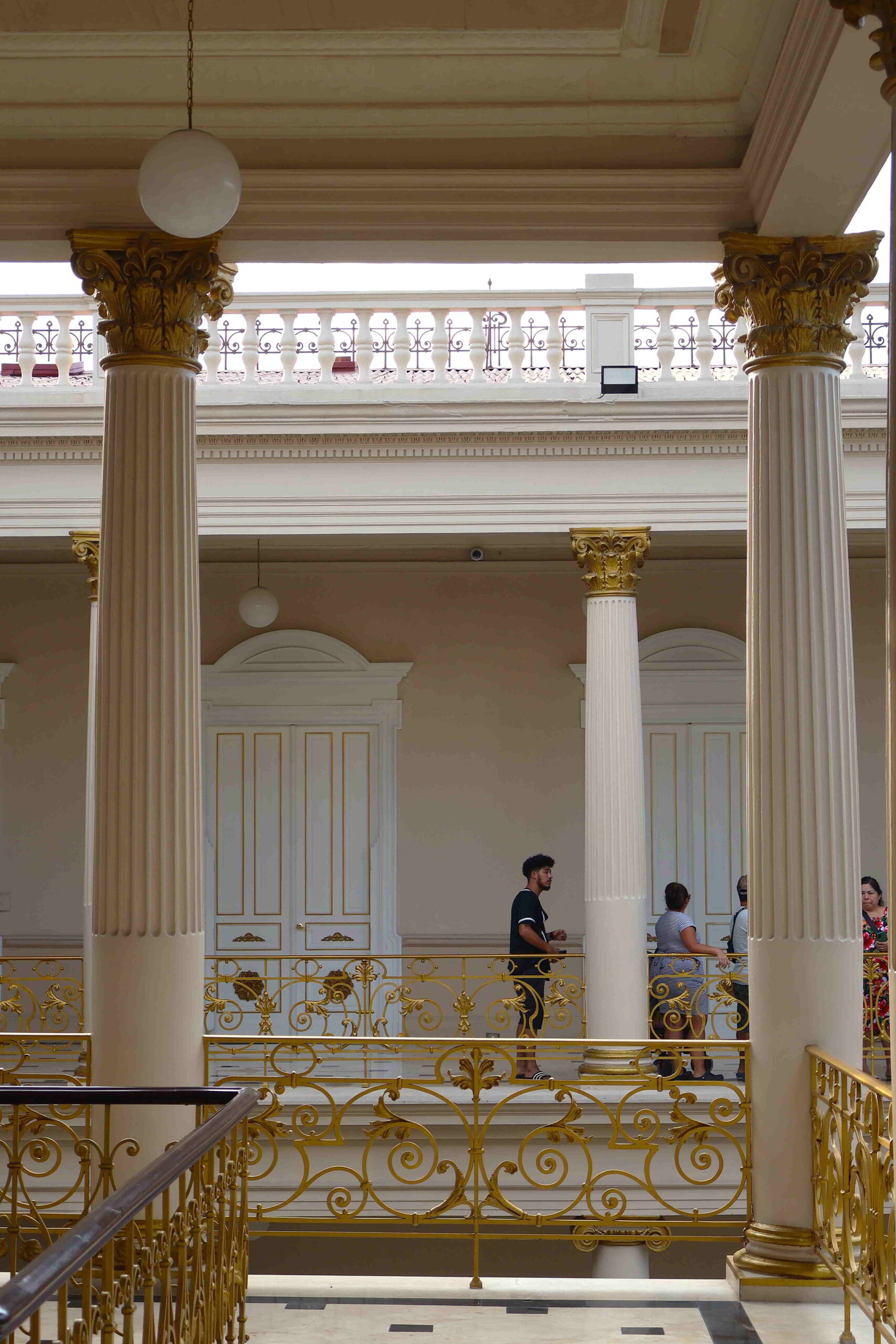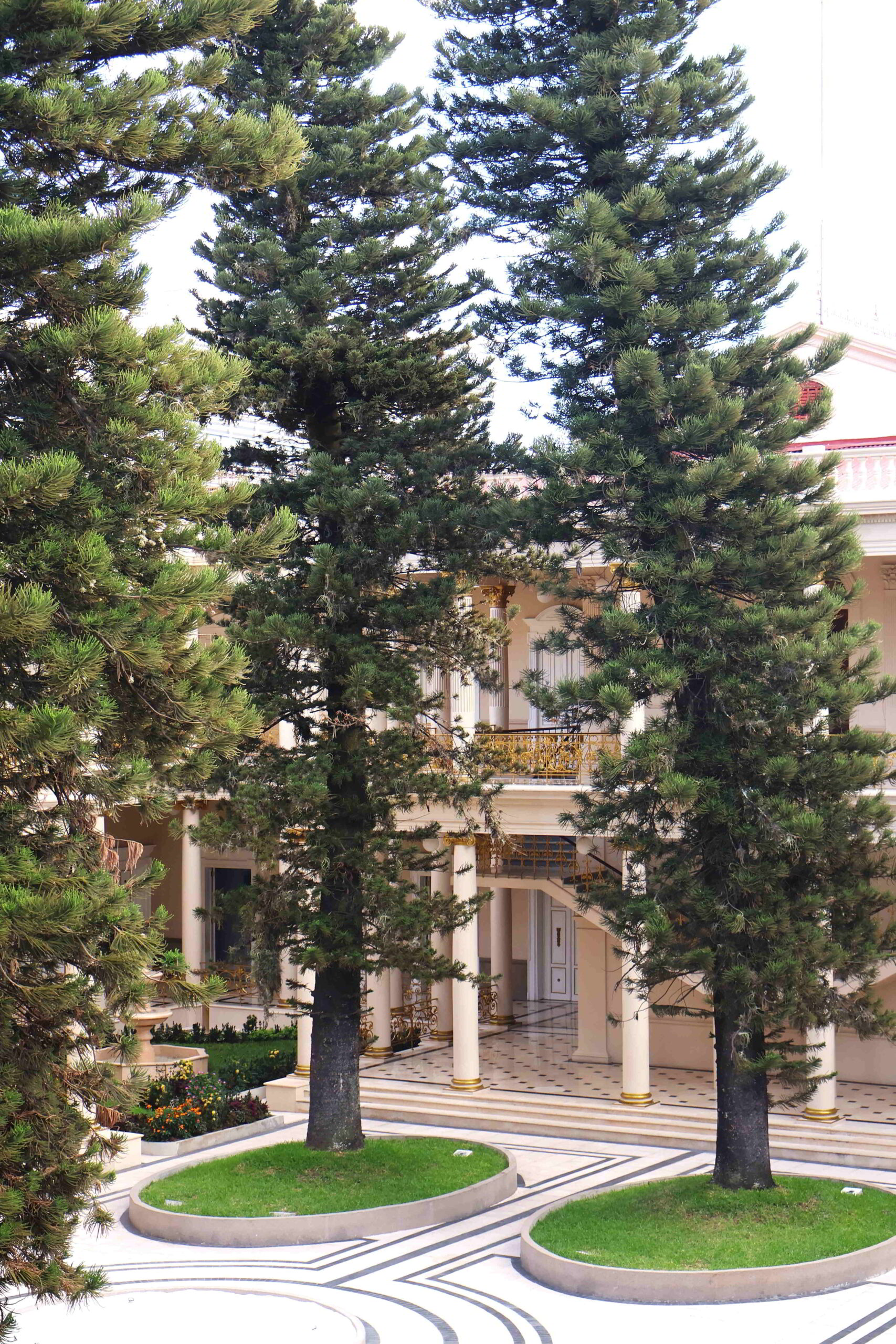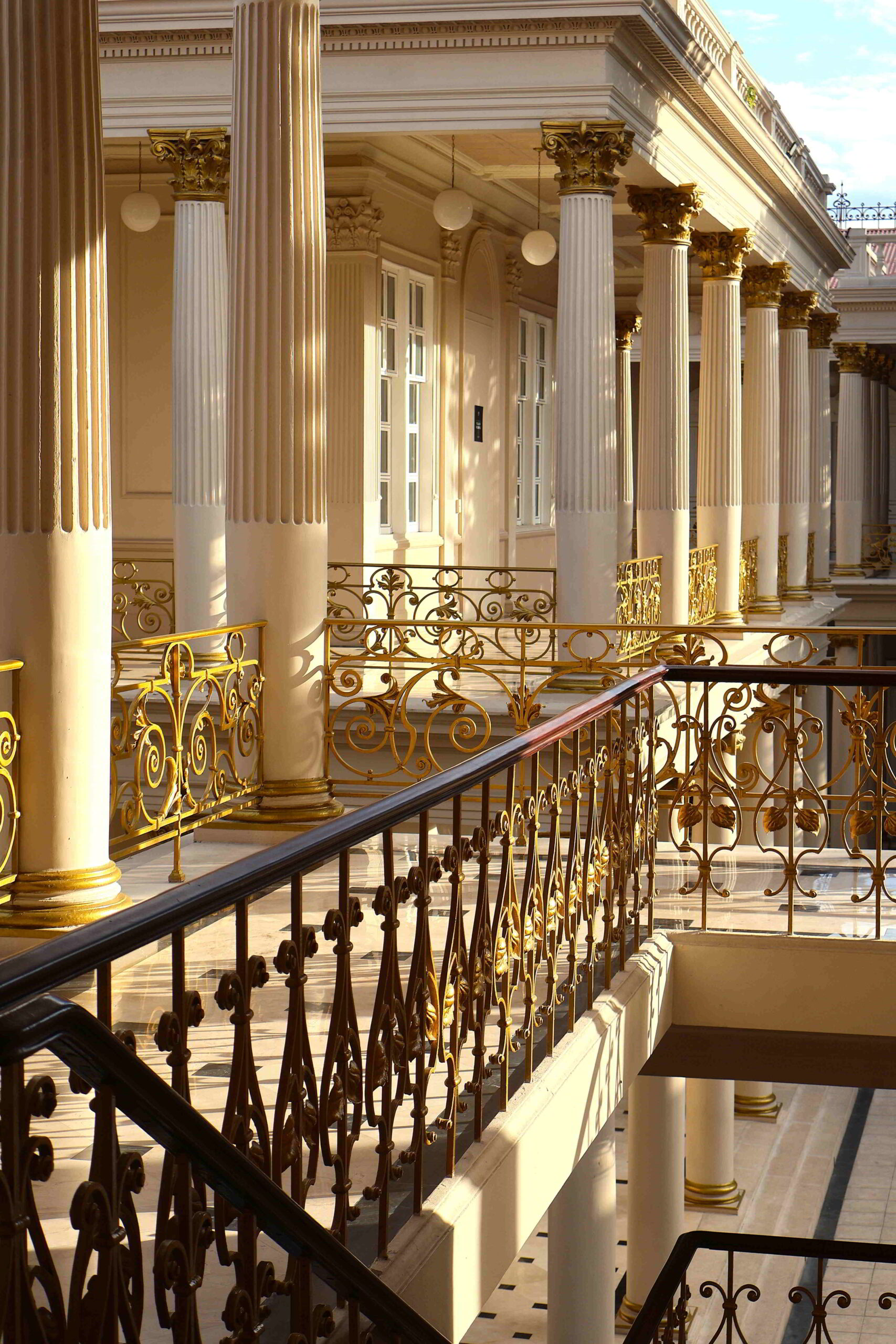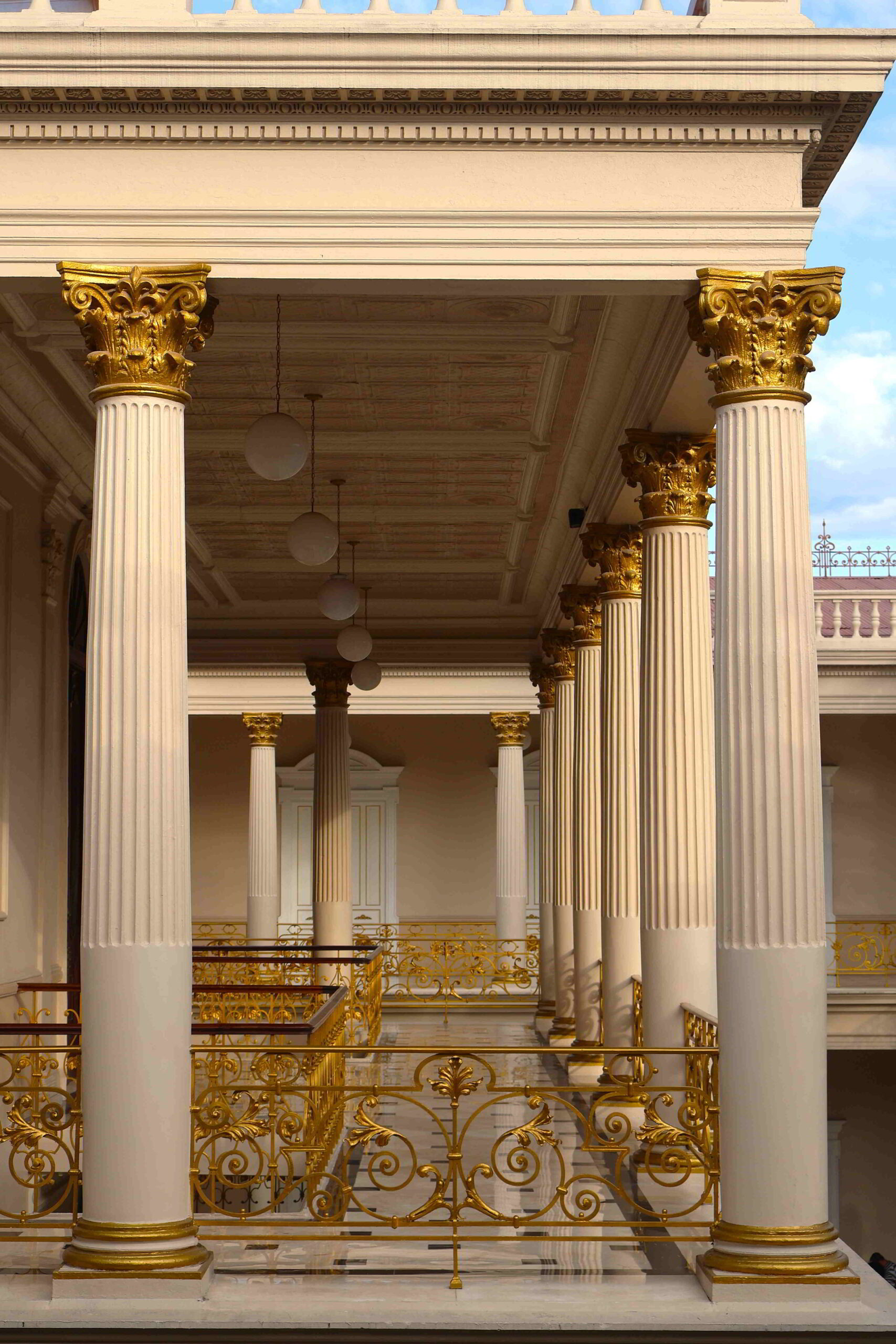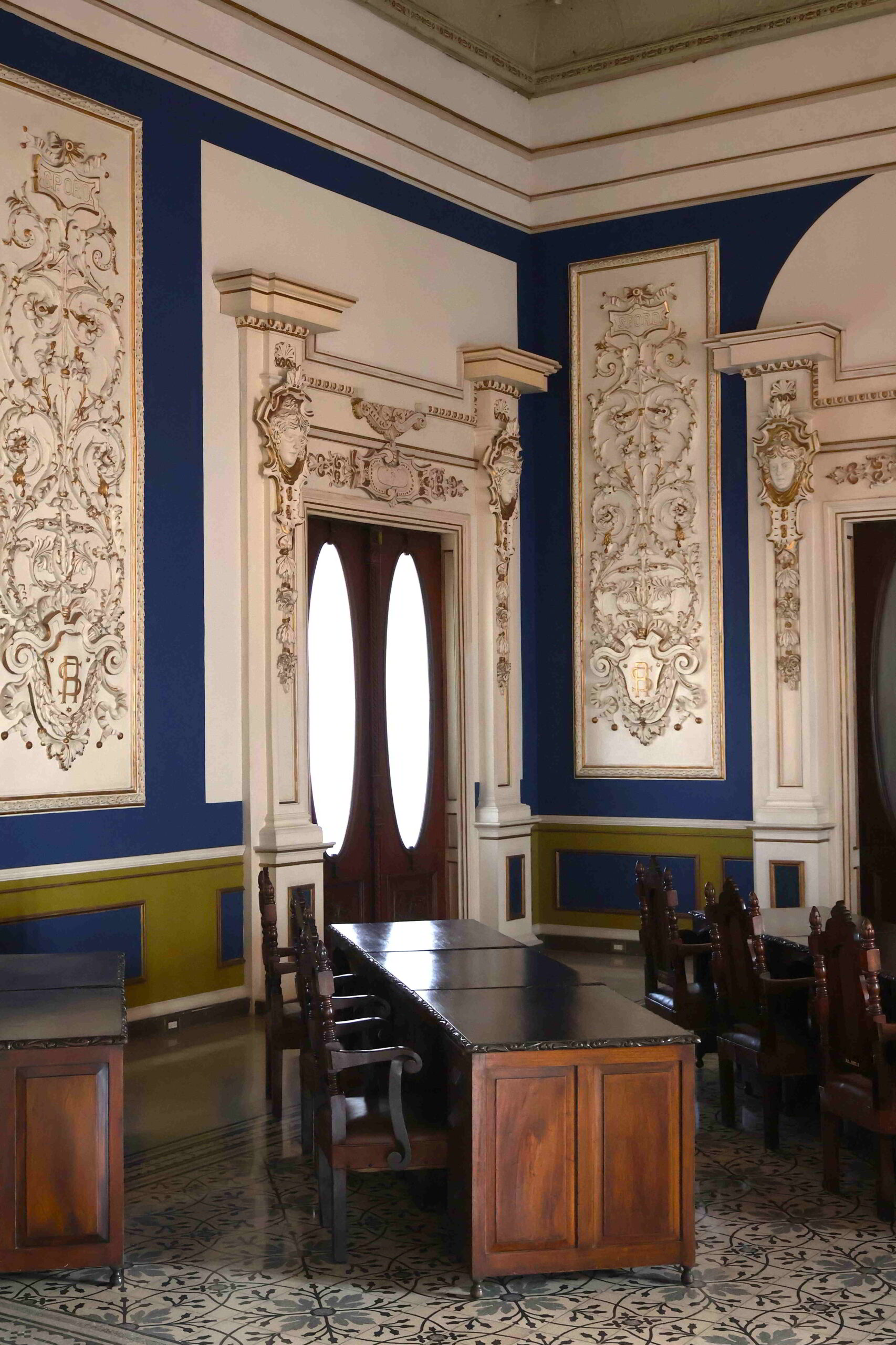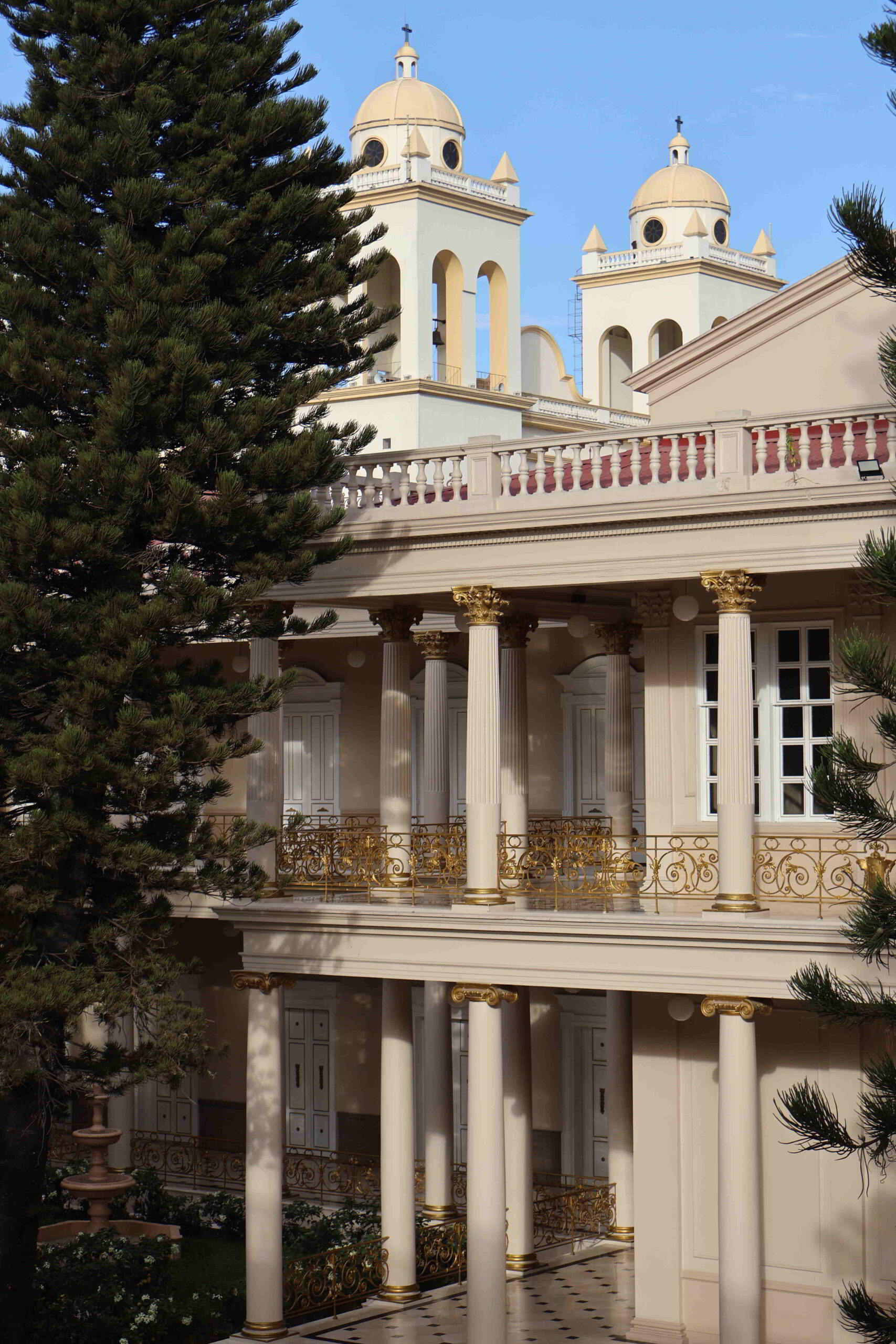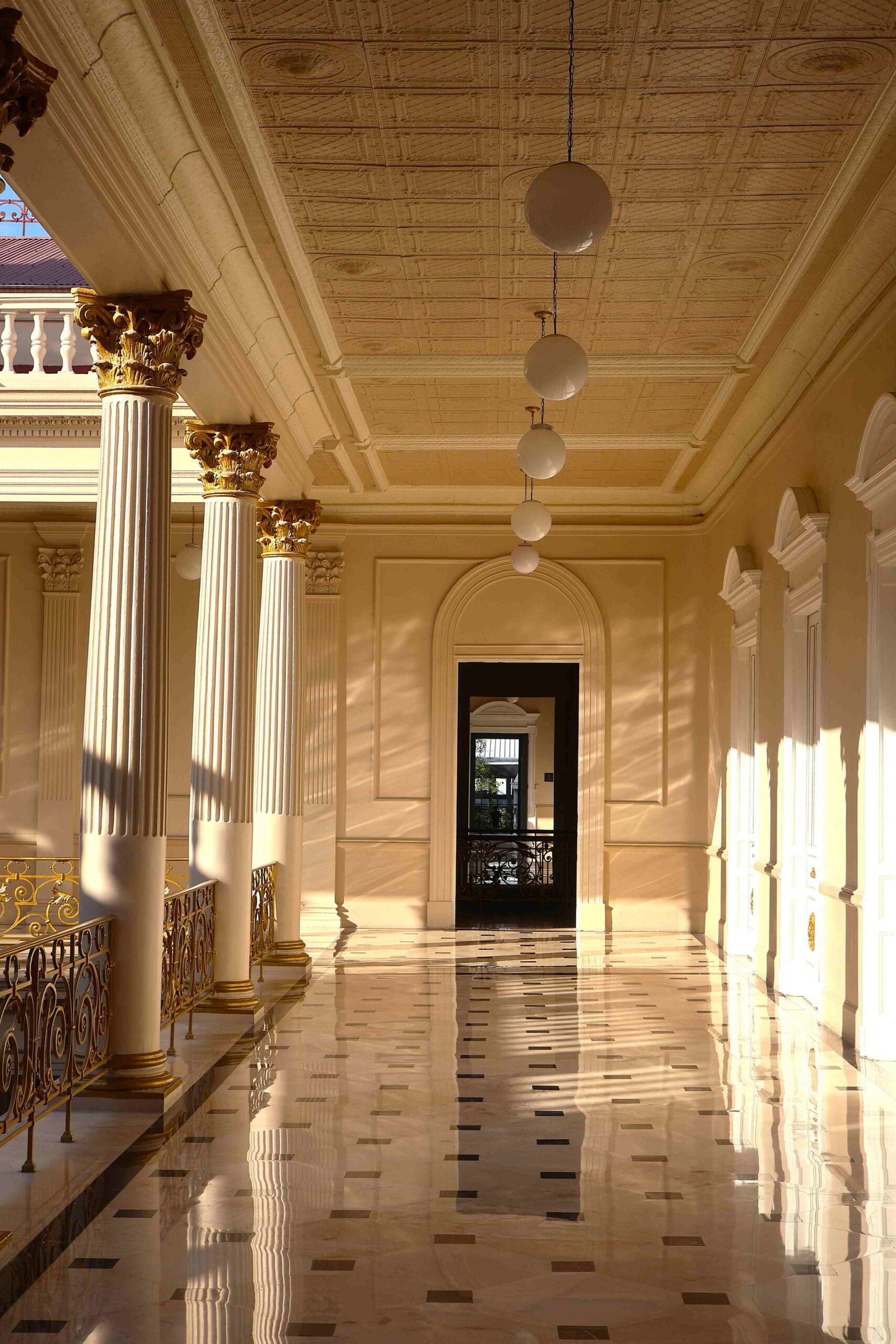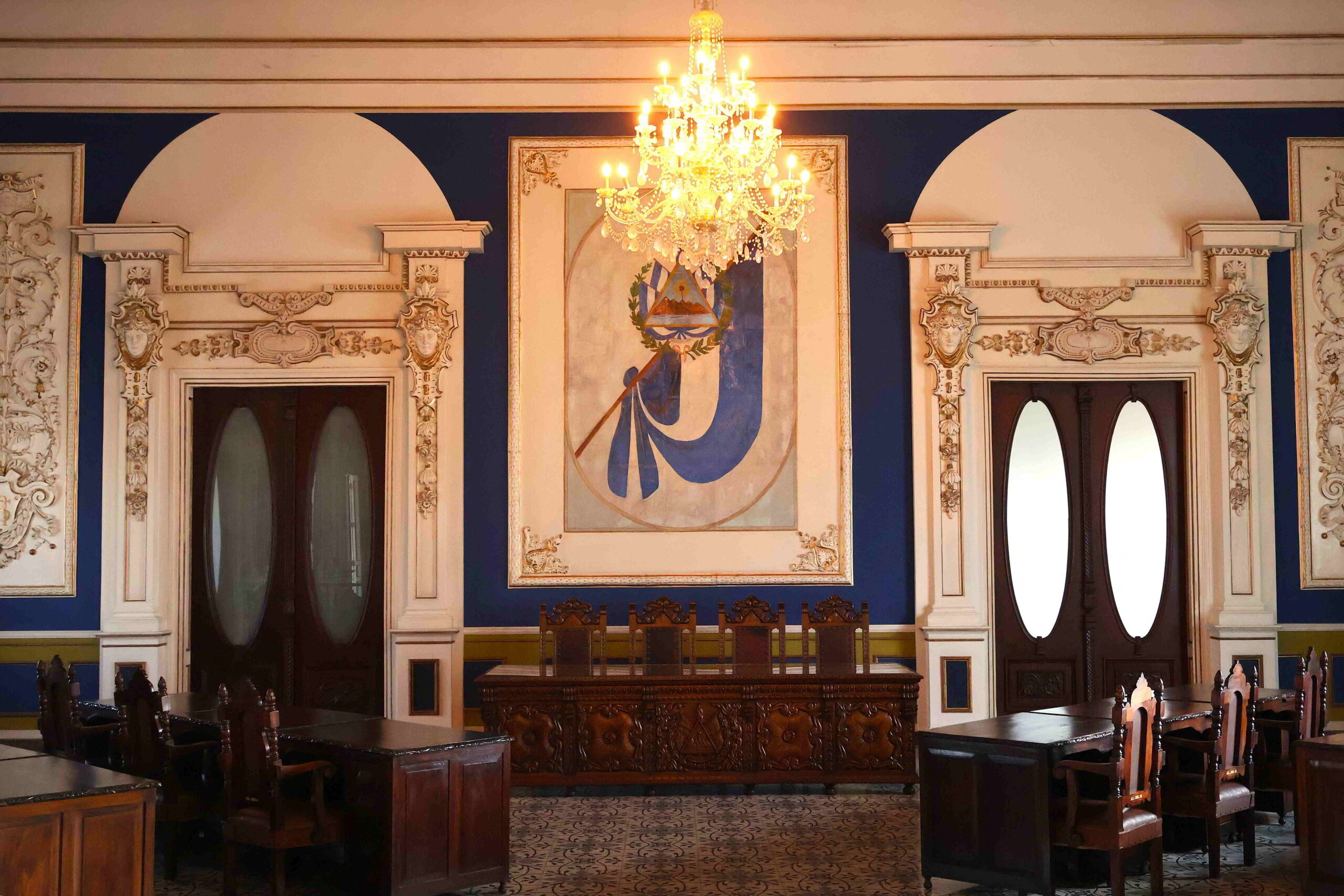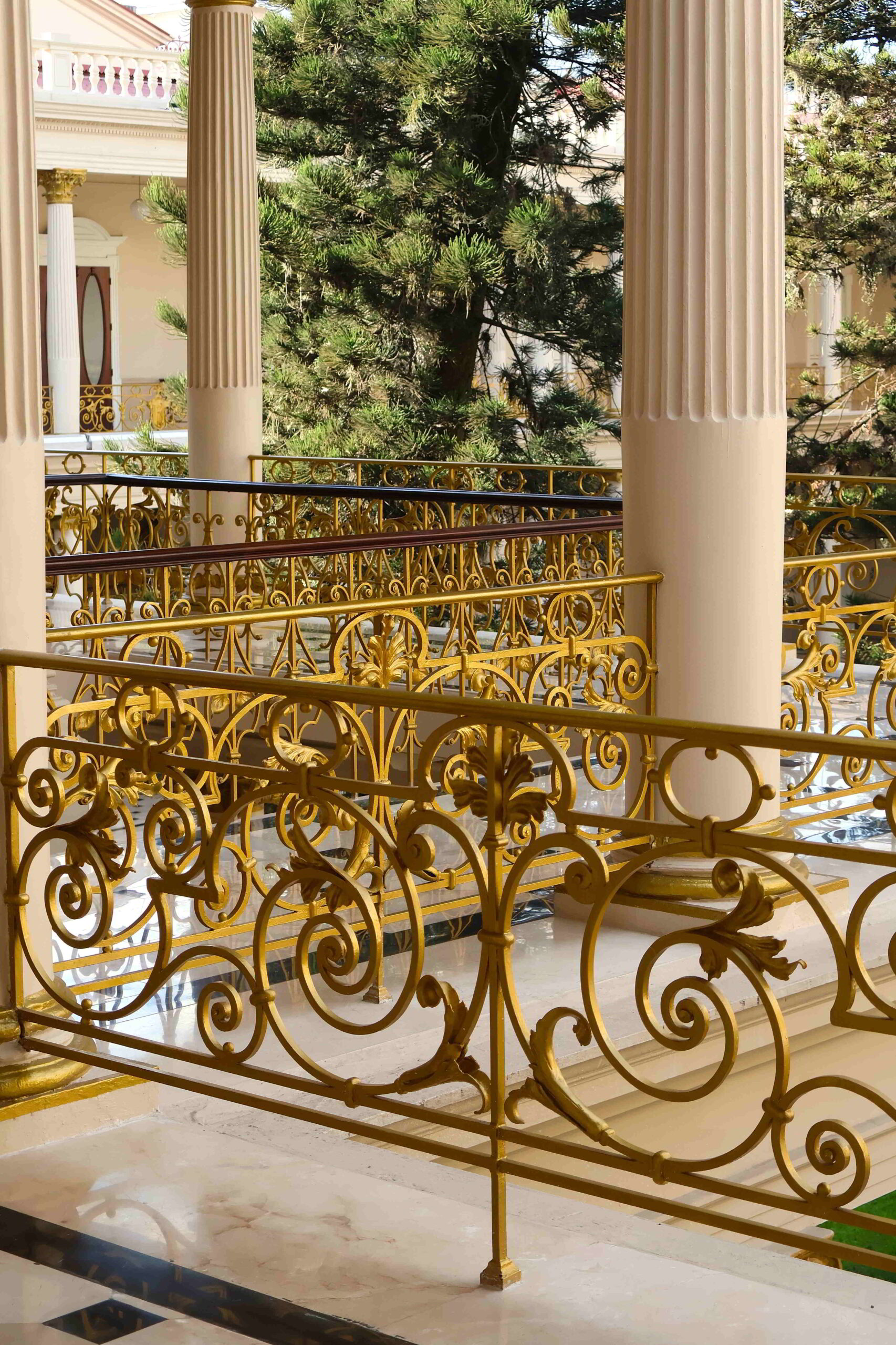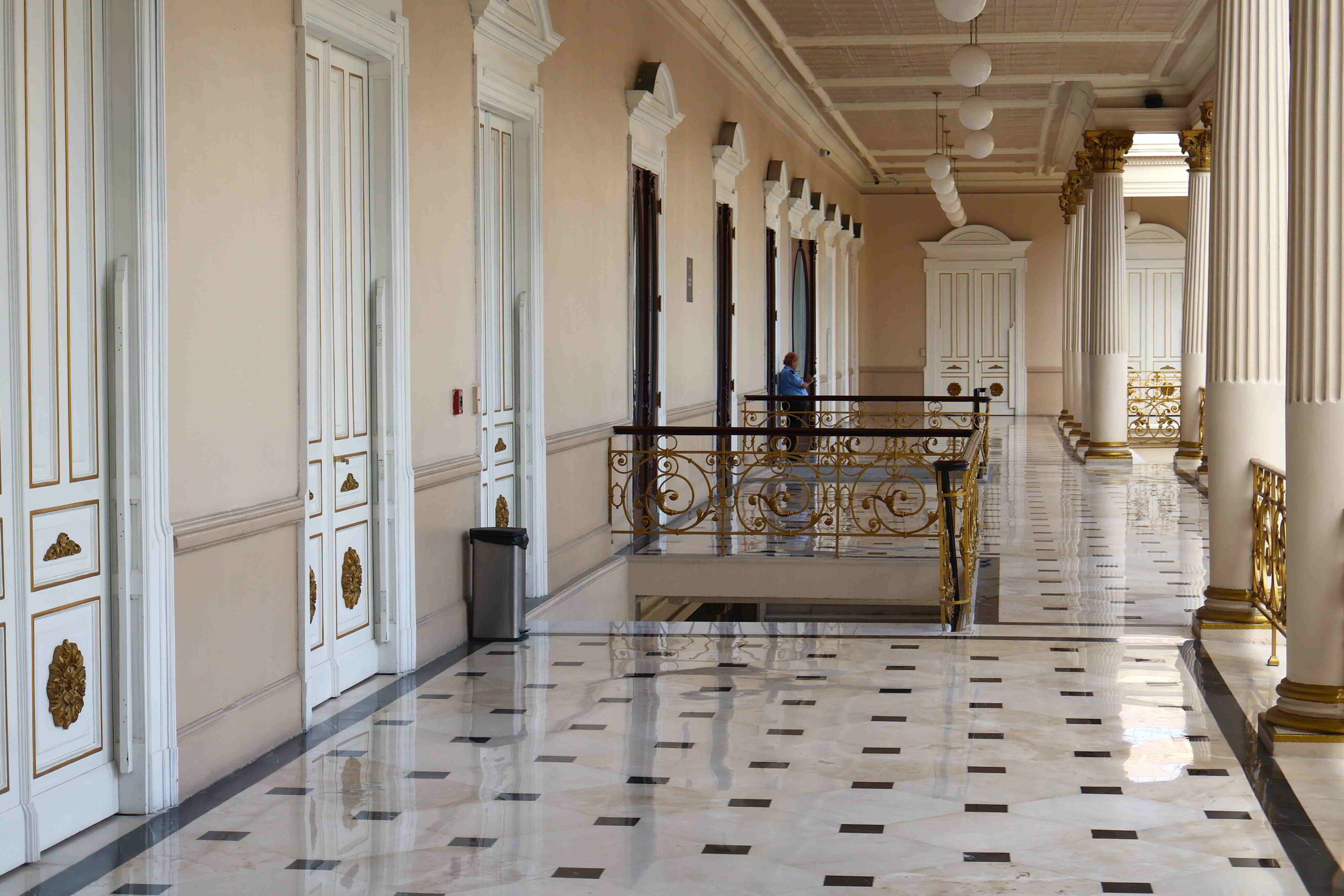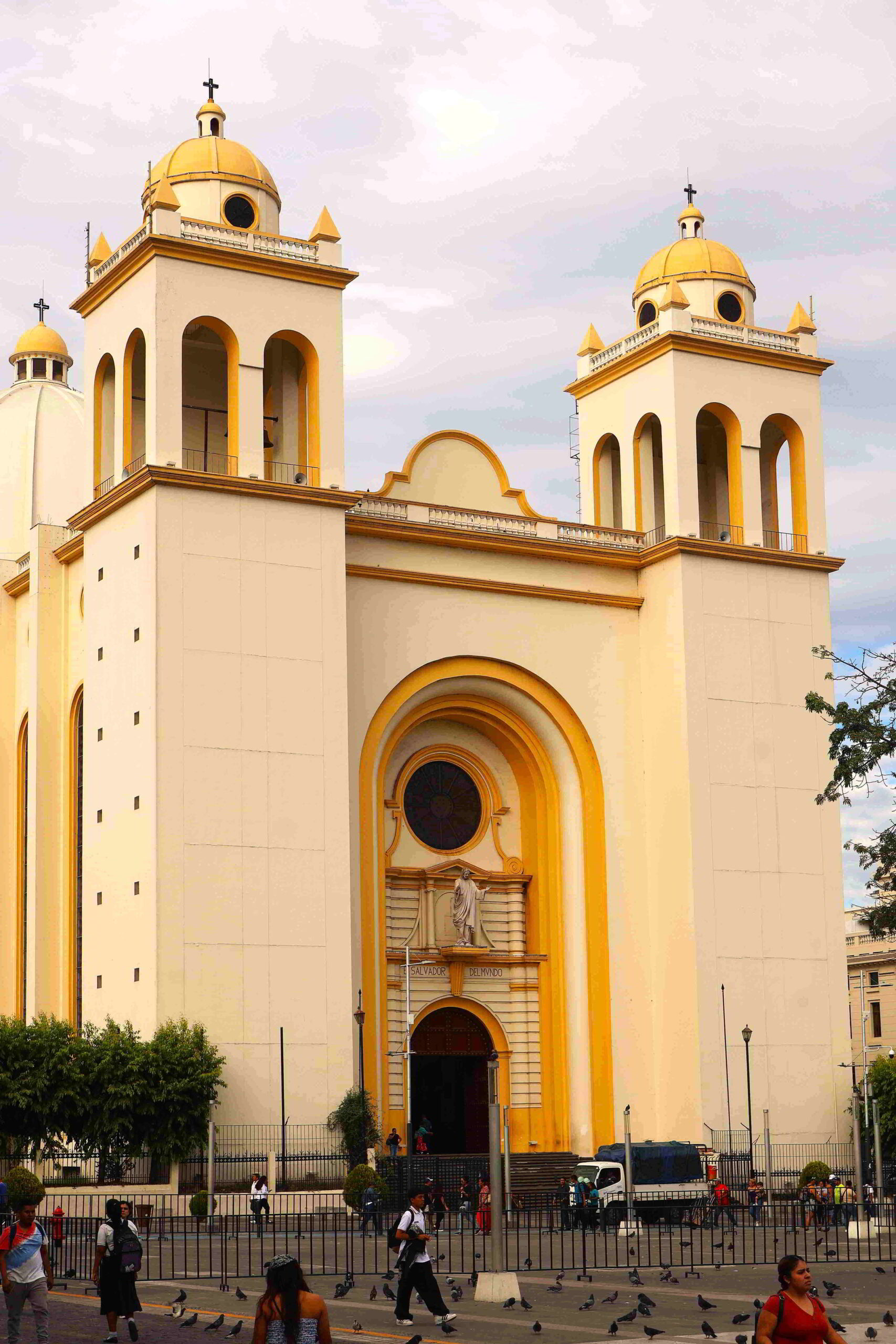January 31, 2025
The plane trip to San Salvador is thankfully not that long, only four and a half hours, with a two hour time zone difference thrown into the mix. Being a red eye flight, I have no hope of getting any sleep, given my innate inability to sleep on planes. The pain of being squished into tight seats and not being able to physically relax (by assuming a reclined position) is mitigated by the relatively short length of the trip. The flight is somewhat turbulent, the nature of the motion suggesting that we are flying into wind shear, although it seems that the turbulence was brought out when we broached the Gulf of Mexico, and abated again when we made landfall in Central America.
Not sure about the vintage of the plane; the interior looks relatively new, but the scuffing in the interiors of the overhead compartments would suggest something different. The seats are thankfully somewhat old school, marginally more ample in size than some of the incredibly restrictive newer equivalents, with what seems to be a touch better pitch, similar to the recent Delta flights I have taken.
I twist and turn in the tight space, my ability to slouch in the seat and extend my legs under the seat in front of me a blessing, although I find it increasingly difficult to remain in one position. I can’t imagine how much more uncomfortable it would be if I had drunk coffee or alcohol, the former fortunately a habit that I seem to be weaning myself from to some extent.
The plane is quiet, befitting the elderly Salvadorean cohort making their way back to their home country, perhaps on their regular visit, or perhaps for the first time in many years, as is the case for the mother-daughter duo I met in the waiting lounge at LAX. The blackness visible outside some of the few windows whose shutters are open transforms into a vivid crimson-peach streak lining the horizon , then dawn quickly emerges, and we are not far from our destination.
The San Salvardor airport is a fairly understated affair, relaxed and not particularly gargantuan, customs and immigration innocuous, entry to the country requiring a U.S. $12 fee payment, a few jokes with the official revealing the inherently jovial nature of the Salvadorean people. We trek onward down the long hallways to the baggage claim, and happily, my bag is already on the belt, which has to be a first!
The procession to the entrance is unhurried, a few taxi drivers calling to me, but first I would like to withdraw money from an ATM, get a local SIM card, message my Airbnb host, and then look for the stop for the bus into town. It turns out that none of the mobility companies have an office here, meaning that you have to buy SIM cards from secondary providers, who charge more and also cannot offer any prepaid phone packages – so I should really look for such an office in town. And the last part also turns out to be challenging.
The is no arrivals lounge in the airport other than a small open-air plaza where locals and taxi drivers wait for arriving passengers. I see no evidence of a bus stop, and after a quick but good coffee, am pointed in the direction of an access road, where I see no evidence of a bus stop, hence continue walking along some adjoining buildings, asking random people as to the possibility of a bus stop, and am pointed in various directions or told that there is no bus service into town at all. One of the risks of trying to get this kind of information from passers-by is that it is in the interest of taxi drivers – and any other country in the world – to lie to inquiring passengers, as it ups the chance of earning a healthy sum from the ignorant.
Finally, through a narrow pedestrian passage to a main road that runs along the perimeter of the airport, where I am told that some of the buses passing by the stop do go all the way to the city – a considerable distance from our current position. But all of the passing microbuses are signed for San Luis Talpa, which is the adjacent town. I wait and wait, passengers coming and going, but no bus with a San Salvador sign arrives.
The young Dominican women next to me are becoming increasingly agitated, although it seems somewhat dubious as to what they are even doing here. Following more inquiries, it turns out that some of the vehicles passing the airport may be heading into the city, even if they are marked with San Luis Talpa, and so finally, I am off to the city, thankfully not having to stand on the long journey to a city I have virtually no recollection of from a visit I made some 40 years ago. The landscape sliding by us is green, although the forest in no manner represents an intact, untouched biotope, and the traces of rural settlement are everywhere. The environment is mildly hilly, and makes me wonder if the placement of the airport has to do with the lack of available flat land nearer the city.
From the map, I see that we are now closing in on San Salvador, the winding roads increasingly crowded by development mostly of a shambolic and poorly-maintained nature that doesn’t necessarily represent any particularly significant reveal, as it could be anywhere in Latin America – or the developing world elsewhere. And now we arrive, at least close to the centre, close enough to a Claro office where I can get a SIM card with an appropriately-priced prepaid mobility package. The office is thankfully not too far from the place where I have been dropped off.
The streets look rough, the pavement broken and overcrowded with people, with run-down buildings galore, but I have no sense of precautionary sentiments. Despite the violent history of the country, I feel a strong affinity for the Salvadorean people, who are salt of the earth, some of the humblest people of Latin American, and with the biggest hearts. I see big smiles and waves from people from all directions, which is pretty much what I expect from these people.
The streetscape may not reflect it, but I am actually in the dead centre of the town, a mere block below the main square, the cathedral, former presidential palace, and futuristic library that was added to the mix. Most of the businesses I see appear to be relatively innocuous, although proper enough, glass-encased storefronts, open-fronted eateries, ice cream parlours, clothing stores, the architectural profile of the street pastel-shaded single- or double-level, vaguely colonial in style. The Claro building occupies a significantly larger footprint, and yes, they can definitely provide me with a SIM card and two-week coverage for my visit to the country. However, what should have been a simple transaction becomes complicated by issues with the SIM cards the attendant experiences, issues with the configuration of the card, then lastly, the payment.
Out on the street again, observing the busy flow of pedestrians passing by, window shopping, observing each other, or attempting to sell whatever knickknacks can earn some money. You can see security personnel strewn along the streets, but hardly enough to take decisive action if things suddenly got rough. And yet, I don’t have a sense that safety is an issue in this environment – I guess I will find out more as I explore the city and the country in the next ten days.
The Airbnb host indicated that I can drop my things off at her house but not stay, as it is still too early in the day to check in. I am suffering deep exhaustion – but if I did lie down to rest, I doubt that I would wake up before the evening!
The InDrive is almost $4 to the house? I had mistakenly thought that the Airbnb would have been close to the historic centre of San Salvador, not that I have any recollection of the city from having visited in in the mid-1980s. I definitely garner strange reactions from locals when I tell them I visited the city in the middle of the civil war. But then it turns out that the house is far removed from the centre, and the car has to navigate somewhat of a quagmire of traffic, not necessarily due to the amount of vehicles present on the roads, but the narrow roads, their relatively poor state of maintenance, and the hilly topography to boot.
Weaving along various arteries that diminish to smaller local roads, modest commercial development, shops, workshops, market stalls and residential buildings hugging the roadways, no appearance of grandiose malls or developments of any sort in evidence, further and further away from the core strip that seems to comprise the historic centre of the city, the topography increasingly hilly, the cityscape residential and overwhelmingly green, the modest, single-story structures colourful and eliciting a strong sense of domestic bliss, but with an overarching sense of disrepair as well.
The Airbnb is located in an apartment building on a run-down, overgrown lot at the back end of Colonia Montserrat, the walk to the entrance of the building eye-opening, and not in a good way, considering how run-down and garbage-strewn the lot is. The owner was undecided about letting me access the suite so early in the day, as she hasn’t finished the cleaning yet, but here I am, with all my baggage, utterly exhausted, and wanting to simply not have to carry all my things around the city until the official check-in time rolls around.
The host of the Airbnb seems somewhat neurotic – I had clearly expressed my intent to simply leave my things in her place, then return into town to sightsee, although I wonder how functional I will actually be. Sitting on a ledge in the Pasaje Barcelona of the Colonia Montserrat, I look around me at the somewhat nondescript, colourful, and run-down environment, not quite imagining this as an ideal fit for a neighborhood I would want to stay in in a Latin American city. This could be a rough area – but then any issues on that front would have emerged in the Airbnb reviews. Finally, Becky makes an appearance on the street, effusively welcoming but also apologetic that her cleaning is not yet finished.
Across the run-down grounds of her apartment complex, up numerous flights of an outdoor staircase that is in quite the state of disrepair, near the top we broach her apartment, the interior providing a completely different sensibility from the world outside, modern, spacious, comfortable, with imaginative and artisanal touches, functional, and cozy, with loads of natural light. The two bedrooms are basic, as is most of the furniture, but the space works well, reflecting that the owner probably has been in this business for quite some time, so understands what she is doing. The big screen TV and washer and dryer are of no use to me, but people love those features; the appliances are also mostly very new, another nice touch. The kitchen furnishings are somewhat skimpy, but most of what is there is very usable – and high quality, not the junk you can get stuck with.
The owner of the apartment assures me that a bus runs by the house that can take me into the historic core. Given where we are located, her claim may seem somewhat preposterous – except that I saw the bus pass by the on the barrio road when I was waiting for her. And I don’t have to wait long before another bus arrives and lumbers precariously through the narrow winding alleys that lead in the direction of the centre. The small roads gradually transform into larger ones, the modest, cobbled-together residences transforming into small bodegas and retail spaces, the pavement uneven, the sidewalks in a state of disrepair, wires dangling provocatively from overhead, the traffic congested, and the sun shining beatifically on the proceedings below.
Only a few blocks from the core, close to where I began my foray into San Salvador, the city appears to be very rough, run down, the alleys running on the periphery of the historic district narrow, overwhelmed with traffic, with some semblance of character hearkening back to an earlier era, but now simply grubby and unliveable. Little maintenance seems to have been in effect for a considerable length of time on the buildings in the general environment, although it isn’t clear as to why that would be the case – is it outright poverty? The years if not decades of instability and danger the country has lived with?
The Plaza Libertad anchors the historic centre of the city here as in any other larger metropolis in Latin America, the large square anointed with landscaped gardens, fountains, monuments celebrating illustrious bygone eras, the profile of low-slung colonial-style buildings interrupted by the modernist facade of the Iglesia El Rosario, which occupies the entire eastern flank of the plaza. The stately column erected in 1911, heralding a century of independence from Spain is a punctuation mark in the bloody history of the country, but nonetheless a suitable location for photos. With the masses of locals lounging around the square, I am not quite sure how secure it may be to pull out a camera and take photos, especially as there don’t seem to be any other tourists in the fold.
The west side of the plaza is more elegant, with the preponderance of flowering trees, the perimeter of the square lined with well-maintained Art Nouveau palaces, quaint retail establishments catering to visitors and locals with more generous pocketbooks, selling snacks and souvenirs, and then around the block, the much more ostentatious plaza with the cream-coloured cathedral on the south side and the wildly incongruous avant-garde behemoth that is the national library.
I could wander into the civic plaza with a sense of awe, given its dramatic departure from the innocuous environs of its surroundings in terms architectural prowess and scope, but my immediate goal is a strong cup of coffee to prop up my sagging body – and luckily, there are a few establishments along the east side of the square, very inviting and far more elegant than anything I could encounter in the inner city.
The Silvestre Café & Bistro is the perfect venue to sit lethargically and look out over the square, with the facades of the neoclassical National Palace and fantastical library in view, attempting to reach a degree of stimulation that allows me to embark on the next effort of the day. I may be in terrible physical shape at this point – but the brilliant sunshine bathes the environment in a rich, midday warmth, something that has been painfully absent in the preceding winter months in Vancouver.
Across the broad, sun-washed plaza, the skewed dimensions of the gargantuan library building on the south side, with it symmetrical horizontally-ribbed exoskeleton, visually arresting, but also wildly out of synch with the proto-colonial aesthetic of the neighboring structures. Since I arrive at the entrance of the National Palace not long before the commencement of a scheduled tour, I decide to embark on an exploration of this glorious architecture exemplar, and is the best and easiest attraction to pursue, given the time of the afternoon and my state of exhaustion.
The building had historically been the home of the president as well as the parliament – if I remember correctly – but it is had been abandoned for some time, and furthermore, experienced considerable deterioration during the Civil War. The Neoclassical structure consists of several tiers, each with its succession of grandiose rooms flanked by open, arcaded passages lined with Corinthian columns, their gilt capitals matching the cladding of the ornately sculpted balustrades lining the inner courtyard.
The airy regal nature and restrained palette of the building is rendered all the more spectacular with the majestic araucarias bedded in the courtyard’s assortment of small grassy plots. The girth of the broad corridors is enhanced by the grain and patina of the marble floors; inside the chambers, decorative detailing reminiscent of the Rococo or later periods of European classicism, what with the use of decorative sconces, medallions, patterned stucco relief, Renaissance-style patterning adorning walls in loose communion with the original design tenets of the palace, although on closer inspection, the delicately fluted floral designs adhere eminently to Art Deco sensibilities.
The Palacio Nacional is an incredible gem for the calibre of its original design and workmanship as well as the quality of restoration. Apparently, the building had suffered considerable damage in the civil war, given that much of the fighting took place in the capital city itself. Any restoration have been costly at the outset, but these costs must have been particularly high, given the quality of the artisans employed, almost exclusively imported from Europe.
I find it also striking that the entire restoration took place over a three year period – while there are obvious gaps in the workmanship, the bulk of the building is in impeccable shape. The guide points me to the broad swaths of symmetrically-patterned polished Turkish and Carrara marble floors; even if much of what we see here was in the original structure, the underlying materials and workmanship are of incredible value.
The palace isn’t just stunning due to its architectural features and aesthetics – the play of golden afternoon light on the marble flooring and gold laminate work in the spacious arcades and exterior hallways is absolutely breathtaking. In my usual misanthropic ways, I could have been unmotivated to take a tour of the structure for the mere $5, but have to confess that I was absolutely floored by the beauty of the place. Hopefully, this will be a mandatory stop for what I expect to be a surge in tourism that the country should be experiencing, given that it is now one of the safest in Latin America.
I get a sense that the guide may be on the conservative side, given her facial expressions and posture in response to some of the comments I make about the country’s turbulent history. And yet, despite the stability the country now enjoys, the people are still suffering tremendously; I only need to look at the prices of food in the supermarket and consider that the minimum wage is U.S. $350 a month.
When I mention that El Salvador used to be an industrial powerhouse, she tells it me it used to be – but a lot of that capacity is gone. I am simply amazed the country functions to begin with, given the decades of upheaval, initially given the civil war that finally ended in 1990, then the decades of violence at the hands of the criminal gangs, something that was brought to a dramatic halt with the radical treatment of the country’s new president.
She tells me I should visit the cathedral, as it was the house of Oscar Romero, who was martyred during the civil war. It brings back a surge of memories from an earlier era of my life, the full force of recognition and remembrance of people who sacrificed themselves for the good of their suffering people. It brings to mind that Romero was canonized by Pope Francis, himself controversial as a Jesuit and early sympathizer with liberation theology, something that has earned no end of enmity from conservative Catholics.
I enter the cathedral, although it isn’t really the best time to visit, given that a service is in progress. Wandering around and gawking in such a situation is hardly appropriate; even if the locals weren’t so devout, it would still be an issue. It is an experience to see the throngs of mostly older Salvadoreans, the abuelos and abuelas seated in the pews, perhaps waiting for the next service to begin, or simply resting.
The interior of the church is agreeable from an aesthetic perspective, but hardly spectacular in the scheme of things. I wonder how much of the church would have suffered damage in the civil war and from the earthquakes that have torn the country asunder. But the importance of this church goes beyond its nominal status as the bulwark of Catholicism in El Salvador – it was the church of Oscar Romero, Archbishop of San Salvador who was assassinated in the civil war in 1980 and who was beatified by the church in 2015.
Conscious of the time of day – it is late afternoon and there is not much remaining daylight – I should buy some groceries somewhere close by, then try to find the 10 bus that returns back into the Montserrat neighborhood where I am currently staying. Apparently there is a Selectos supermarket close by, and just around the corner from the Plaza Morazán, things quickly look rough, with a very different demographic from the happier and sightlier crowd on the square in front of the National Library and National Palace.
But these are working people, trying to survive in some fashion or for that matter, rushing home from work, possibly running some errands on the way. And there is little question as to the innate warmth and sense of welcoming that locals elicit. Fast food of reasonable quality and variety is available around me, which is a nice marker of a society, beyond pupusas, nothing particularly exotic, but good, home-cooked food that is also reasonably-priced. Several ice cream places line the street, and as I am somewhat thirsty, should embark on a rare foray into one of these places – and it seems that U.S. $1.80 for a cone with two huge scoops of ice cream seems like a pretty good deal – never mind that the ice cream is actually very good, which is also quite surprising.
The Selectos is an outlet of what is presumably a larger grocery store chain, the usual somewhat bedraggled place with fully stacked shelves, but on closer inspection, with what seems to be a very good selection of most types of foods you would find in supermarkets. And interestingly, even for Latin America, prices are relatively reasonable for a lot of the basic goods. I wonder to what extent a lot of the merchandise is made or grown in the country.
